#there may be some MINOR editorializing on my part here
Text
11 May 1968

Power couple John Lennon and Paul McCartney make a trip to NYC to promote their new venture, Apple, and as a last ditch effort to save their relationship. Unfortunately, neither of them seems to agree on how best to accomplish either one. But they look great doing it.
#there may be some MINOR editorializing on my part here#but not much i think#today in the life#the beatles#paul mccartney#john lennon#apple inc#11 may#1968
205 notes
·
View notes
Text
Issue 29, containing: Housekeeping (Nondiagetic), An Interesting Method for Skimming Wax, Some Advice for Those Seeking the Northwest Passage, A Partial Guide to Avoiding Casual Poisonings, Letters, Commonplaces, &c.

------------------------------
SOME EDITORIAL NOTES
A new year, and here we are. Welcome. There's fresh bread from the oven, with which I have just eaten a slathering of local maple butter, and with which I will later make a deeply hedonistic grilled cheese.
I will attempt to keep my concentration on the writing of these articles, rather than the promise of dairy yet to come.
------------------------------
HOUSEKEEPING (NONDIAGETIC)
I sometimes think about the inaccuracy of the subtitle of this microzine-- which, if you'd rather not stare too closely at the miniature text in the header, reads in part:
"a newsletter of miscellany, fiction, and art"
(I am omitting my name from the subtitle, as, if I had my druthers, I would not list a name at all, but rather credit this whole venture to an anonymous collective of Editors bravely trying to rein in an errant essayist who seems hellbent on style over substance.)
(Also I have been reliably informed that I should, quote, "get over it.")
Of the numerous things currently annoying me about the subtitle, above and beyond naming conventions, there is also the use of the terms "newsletter," "fiction," and "art."
("Miscellany" may survive the cull, because it is both accurate and also a pleasant word to say.)
(Miscellany. Mys-cell-aye-nie. It looks like Arkham might loom behind it while the scent of salt and cold brine inexorably rises in a grey and creeping mist.)
"Newsletter" is doesn't feel right, though I haven't quite determined what might be closer. "Fiction," regardless of the actual content of some of these articles, doesn't feel accurate either. And "art," even assuming a gentle reader might deem my photographs as such, was always a stretch.
And so while the header remains as it is for the moment, a change is on the wind. I've been spending an even greater amount of time than usual reading through the older magazines and publications that The Minor Hours seeks to emulate, and, to the Editors' horror, I must confess that the feral urge to use the word "diuerse" grows stronger by the day.
------------------------------
AN INTERESTING METHOD FOR SKIMMING WAX
As long-time readers may recall, part of my overall journey toward kitchen witchery and experimental archaeology has involved finding and working out the recipes behind historical foods, cosmetics, and home goods.
The most recent of these that exist within the "fairly complete now, thank you" category is the recipe I've worked out for a pomatum suitable for the lips, variants of which I've found in several old scanned and OCR'd texts, with the mid-1600s being the earliest occurrence so far (and somehow involving-- grapes?) and the latest appearing in and around the 1710s.
I would share that recipe but, sadly, I have done so elsewhere; instead, let me share a stranger revelation: the matter of wax, and its cleanup.
One batch of this pomatum requires an ounce of beeswax. I have lately been made aware that beeswax is not a grease, and therefore dish soap has no power over it; it is also not a fat, but woe be to those who seek to pour it down a drain, lest it solidify just as much as a fat might when cooled.
Following the recommendations of those who have come before me in the modern age, I have instead tried to boil the wax off of whatever objects they come in contact with. This works-- to a degree. Since the wax does not magically disappear, I can at best only transfer the wax from one object (my pomatum-making tools) to another (the large pot I found at the thrift store and am sacrificing for the greater good to the wax gods).
There is, however, an intermediary step: skimming.
As the wax melts in the boiling pot, it leaves its moorings and floats to the top of the heated water. From there, a small mesh strainer, as one would use to hoist out a dumpling or, indeed, skim the top of some liquid creation, can be used in a nice repetitive manner to remove the majority of the melted wax.
--Or.
I found, as I skimmed, that I wasn't truly gathering everything. I knew this to be the case because using the strainer was actually my second attempt at collecting wax. The first was the slow but incredibly effective method I found while hunting around to begin with: that of the Cold Metal Spoon.
Take a metal spoon and, in its bowl, set an ice cube (or however many should fit in it). The metal now instantly chilled, draw the back of the spoon across the top of the hot, waxy water. The wax, hitting the cold spoon, will immediately cool and cling to the metal, allowing you to collect far more wax that the mesh strainer managed.
As a demonstration, behold:

Fig. 1. The back of an as-yet-unwaxed spoon.

Fig. 2. Spoon avec ice.

Fig. 3. Besmirched!

Fig. 4. The lady, half revealed.
I am, overall, extremely pleased with this method, and only seek now to find a significantly larger metal ladle.
------------------------------
SOME ADVICE FOR THOSE SEEKING THE NORTHWEST PASSAGE
Pack a compass.*
* While the pointing Hand of Franklin† has been listed under "Preferred Equipment," it will not be available for the foreseeable future.‡
† No note was made of the properties of the non-capitalized hand of Franklin, and it is therefore excluded from these pages.
‡ This is largely because the body of John Franklin§ is also not available for the foreseeable future.
§ Further, it should be made clear that the Hand of Franklin, regardless of its present location, would be contaminated with lead, botulism, and possibly toothmarks, none of which have been found to be reliable aids to navigation.
------------------------------
A PARTIAL GUIDE TO AVOIDING CASUAL POISONINGS
With the success of the lip pomatum, I've found myself eager to explore historical recipes further. This leads, unfortunately, to two additional concerns: (1) determining the modern-day equivalent of various ingredients, and (2) ensuring that those same ingredients are not, in fact, poisonous.
[Interestingly, the tertiary concern of "is it legal to seek out or possess these ingredients" does not appear to have made this list. -Eds.]
Even the pomatum itself required some of this research.

Fig. 5. A recipe containing two bad ideas and one very good way to explode a fine mist of wax over one's entire kitchen.
Of the bad ideas, let it be said that:
Fresh butter was an English addition to this receipt. The original French listed sweet almond oil, which contains significantly less likelihood of poisoning the users of the pomatum through molds, bacteria, and the general horror of applying butter to one's face.
Orcanet required some study, but revealed itself to be an older spelling of alkanet, or what we now might purchase under the name alkanet root, Alkanna tinctoria, or ratan jot. While it is a popular colorant for the makers of "natural" cosmetics, there is some concern regarding what happens to the livers of people who ingest it, and it therefore seems unwise to include in a lip balm.
(Hilariously, the receipt itself only lists orcanet as necessary for thickening-- and assuming that that was the case, I replaced it with powdered arrowroot and went about my business. However, in researching alkanet, I didn't see any particular mention of thickening properties... but I did see that while in alkaline solutions, alkanet turns blue, in acidic solutions -- such as any that might contain orange-flower water and sweet almond oil -- it turns a lovely shade of crimson.)
(But it was included in this receipt only, of course, for thickening.)
Of the good way to explode one's kitchen, let it be said:
An important lesson can be learned regarding the application of room-temperature hydrosols to a wax-and-oil mix heated to somewhere above 145 degrees Fahrenheit.
The lesson is "don't."
------------------------------
LETTERS
Received by the Magazine via a Dream, Probably, "On the Subject of Mountains":
To the Editors:
While we acknowledge your appropriate appreciation of our regality [Issue 28, "Regarding Mountains" - Eds.], we wish you to know that we of course hold a deep interest in the termination of human lives. We merely do not feel the need to be as obvious about it as our young neighbors to the east. Murder is folded into our orogeny. We cordially invite you to visit again any time to explore further.
Sincerely,
The White Mountains
******
From the Editors, to The White Mountains, "We Had to Look Up the Word 'Orogeny'":
The Editors would like to humbly, and from a distance, like to apologize for continuing to think of you as the Green Mountains, due to the unfortunate necessities of nomenclature and the observances of faith required by certain large and bloodthirsty deities previously referenced.
Having now completed the niceties, we would also like to relate that we have been reliably informed that our mountains are stronger, more shredded, and could kick all your asses if you were inclined to meet in the parking lot after school.
We trust that this letter meets you in good health and with kind regards,
-The Editors
******
Received by the Magazine through Diuerse Worrying Methods, "As It Pertains to Sleeping in New Places":
Dear Editors:
Please accept our apologies re: the moving of everything to the Wrong Place. [Issue 28, "Sleeping in New Places" - Eds.] AirBnB guests keep moving things, and we hate it. Our malevolence is restricted only to them, not to guests of the family.
Telekinetically yours,
The Ghosts of the House
******
From the Editors, to The Ghosts of the House, "Ghost Are Often Memories, Accessed in Ways Both Strange and Humbling":
The Editors have cause to remember other guests in the House-- of which one, more kin to you than the others, decided to wander to the familial cemetery to visit a little while with the dead. It was dark out, and the land rolling underfoot, and they declined a lantern for the way.
Being of a narrative inclination, this struck the Editors unwise; being sadly entrenched in a world that rarely requires the services of the genre-savvy, we can only assume that that which returned from the graves matched in all particulars the person who had left.
It is wise, sometimes, to let the ghosts have their way with things, and to have a healthy respect for howsoever they might wish to conduct their business. To that end the Editors would like to assure the Ghosts of the House that they felt as welcome as any traveler could hope, and that they very definitely won't report any strange activities their Kin might engage in of a ghost-like or alternately-revenant nature.
------------------------------
COMMONPLACES
From Jessica Hayworth, "story about a lake I did recently":
>>Woman: A LAKE OPENED UP INSIDE MY CHEST.
>> Woman: I THOUGHT WOW, THAT'S NEW. NEVER HAD A BODY OF WATER IN ME BEFORE.
******
From Jessica Hayworth, "story about a lake I did recently":
>>Interviewer: DID YOU HAVE TO INVITE IT INSIDE?
>>Woman: I DON'T THINK A LAKE ASKS PERMISSION.
>>Interviewer: [laughing] NO. NO IT PROBABLY DOESN'T.
>>Woman: [laughing] IMAGINE THAT.
>>Both: "HELLO I AM YOUR LAKE. I HAVE ALWAYS BEEN YOUR LAKE.
>>Both: "OPEN UP PLEASE. OPEN."
>>Both: "OPEN SESAME."
------------------------------
ANNOUNCEMENTS
I'm going over-long as it is, but it should be noted that there are New Tiers on the Patreon, which I will probably talk about at some point. I make no promises as to when, however, because time is a lie.
Welcome to 2023. I'm going to go make a grilled cheese.
******
If you would like to write a letter to be produced/answered in the magazine, please email me at [email protected] with the subject line:
Letter to the Magazine: [subject of letter as you would like to see it printed]
If you wish the letter to be anonymous or under a nom de plume, please state so in the body of the email; similarly, if you'd rather not be printed at all, please also state so in the body of the email. It will otherwise be assumed that mail sent to that address is intended for print.
Alternately, commenting on the Patreon post will get you a similar result, with much less fuss.
******
As always, you can find me at my regular website, katherinecrighton.com, or sometimes via twitter, at @c_katherine.
To support the magazine and get it delivered directly to your inbox, join the Patreon.
-Until next week, be safe.
9 notes
·
View notes
Text
Processes synonym

Processes synonym how to#
Processes synonym full#
Processes synonym software#
In addition, MDPI offers Authors Services () before paper submission. APC information is also available via the journal menu. Information on service function by APC breakdown is provided, as well as accepted currency and methods of payment. The APCs currently range from 1000 CHF to 2400 CHF (Swiss Francs). You can find information about each journal’s Article Processing Charge (APC) on MDPI’s website ( ). How much are the fees (Article Processing Charges)? In addition, all papers are available online as soon as they are published. Our in-house editors around the world offer 24/7 services. None of the steps or processes are outsourced, allowing us to maintain close control of the quality and efficiency.
Processes synonym software#
All the editorial, production, and invoicing steps are managed using MDPI’s SuSy and are performed by in-house employees, largely using software created and maintained by MDPI. MDPI prides itself on the high speed and flexibility of its publication. Authors can find out more about the publication time of a particular journal by locating that journal’s statistics via the journal menu. MDPI’s median publication time is 40 days from submission to publication, which includes around 16–17 days for a first decision, and just 5 days for final production. Please note that, if there are reviewer recommendations that have not been sufficiently addressed after two rounds of revisions, rejections or resubmissions may be warranted. Most of our journals suggest 5 days for minor revisions and 10–14 days for major revisions. MDPI has one of the most straightforward and efficient publication processes in the whole publishing landscape. Our Editorial Office may agree to extended revision time, provided that the authors send their request to the in-house Assistant Editor. Can I ask for an extension on the revision deadline? Contributions should be listed during the submission process and are also part of the journal template. MDPI joined CRediT ( Contributor Roles Taxonomy) early on in the initiative’s launch. Do I have to specify author contributions? You can find these templates in the Instructions for Authors section, accessible from the journal menu. You are therefore encouraged to use the journal’s Microsoft Word template or LaTeX template (including Overleaf) to prepare your manuscript. When submitting your manuscript to SuSy, it will start with an option to select whether or not you have used the journal’s template some of the fields will already be filled out if you use it. If you submit without using an MDPI template, the Assistant Editor will help you with the layout during paper processing. Does my submission have to use an MDPI template? However, if your paper is less than 3000 words or more than 12,000 words long, we recommend that you contact the Editorial Office in advance. There is no limit to the length of papers! We encourage authors to publish their experimental and theoretical results in as much detail as possible.
Processes synonym full#
The full list of MDPI journals is available here. If you are still unsure, you can use our new Journal Selector tool or contact the journal’s Editorial Office. You can find out about the journal’s scope in the Aims & Scope section, which can be accessed via the journal menu, or by searching for individual Special Issue webpages. How do I find out if my title/abstract fits into the scope of the journal/Special Issue? Papers are submitted via SuSy (MDPI’s Submission System), at. The submission process starts in the same way for each of MDPI’s journals, by clicking on “Submit” on the journal website. Authors can also reach our Editorial Office using the contact details in the journal menu.ġ. Make sure to share any further questions in the comments.
Processes synonym how to#
Here are answers to some of the questions that we are asked most often about the submission process, along with a video explaining in detail how to upload your manuscript. Authors retain the rights to their published content. We are passionate about publishing high-quality research in all academic and scientific fields. As part of our service, an in-house Assistant Editor is assigned to each manuscript. At MDPI, we want to ensure that the submission process runs as smoothly as possible for our authors.

0 notes
Text
Comic Review: Cartoon Network Presents #6

I said I was gonna do this, so let’s get this rolling!
Okay, so Cartoon Network Presents was among the first lineup of DC’s CN comics, alongside their Scooby-Doo book and The Flintstones and the Jetsons. Those are pretty self-explanatory, but CN Presents was meant to be a grab bag of the rest of their lineup, featuring favorites from the vast Hanna-Barbera library as well as some of their recent hits. At this point, I believe they were just doing Dexter’s Lab and Cow & Chicken, as Johnny Bravo’s first season was more or less written off as a failure at the time. But don’t worry, Johnny will have his day.

Okay, so confession time- this story is not new to me. Way back when, DC released a freebie comic which had stories from each of their three CN titles, and this was featured in there, alongside a short Scooby story where a stalker keeps on doning a costume to get closer to Daphne, and a Jetsons story where George is replaced by a robot version of himself. Needless to say, some serious memories came crawling back to me when I saw the cover.
Anyway, both of the stories featured in this issue are done by regulars in the comic industry, and I’ll bring up how apparent that is in a bit,
That said, I can see this story actually fit in an episode of Cow & Chicken, as it’s a cautionary tale that doesn’t go in the usual direction you’d expect, like many of David Feiss’ cartoons tend to do things. This starts off with Chicken littering, which goes against what his and Cow’s teacher taught them in school. Chicken, as per usual, is apathetic to his loud teacher’s learnings, but he changes his tune when Cow mentions that bringing in metal can bring you some change,

Needless to say, Chicken has some ideas, and he starts scourging around town. There’s a slight detour when he learns that you only receive payments from going to the trash collector directly, but it gives him incentive to have Flem and Earl help him out.
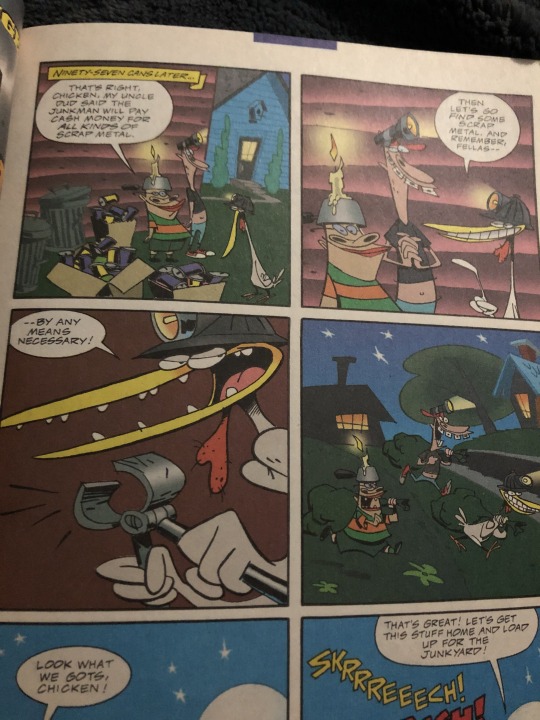
Alongside a dubious reading of Malcolm X’s philosophy.

The three of them find enough metal to hopefully make them a little richer, and they’re greeted at the trash heep by a weird looking Cerberus creature, and guess who they belong to!

Yeah, it’s the Red Guy. It’s not a Cow & Chicken segment without him, is it?
I had a better screenshot of his appearance, but it came out weird and I don’t feel like taking another, so let’s skip to this part where Chicken is caught cheating the scale, and is about to be rightfully punished along with Flem and Earl. Not by death, but by filling up the Red Guy’s furnace, which is actually pretty fair.

But have no fear, Supercow is on the way to come save the day! This comic even translates her dialogue for us, which the show never did.

It ends with her beating the shit out of Cerberus and the Red Guy, even though Chicken deserves his punishment. Flem and Earl, not so much.
It’s a fun enough story, and it does seem like a perfect fit for the show. The dialogue fits right in with the show.

Even Flem’s awkward, vaguely racist broken English. I’m not touching that one...
The art style is a little off, though, looking more like a regular DC comic than an episode of Cow & Chicken.

I mean, it looks like Chicken, but doesn’t the penciling look closer to an issue of Robin at the time instead of something? But it’s a minor complaint, as it’s still a fun read.

The b story is new to me, with a Quick Draw McGraw story. It starts off pretty ordinary, as El Kabong OLE’s himself to save the day. Er, not that ordinary, as El Kabong is a bit of a klutz and usually needs Baba Looey’s help, but it’s okay, something’s about to change.
It turns out that El Kabong’s identity may be liable for copyright infringement, as there’s a Canadian crime fighter known as Le Kabong.

We meet him here, and I believe he’s meant to be Loopy de Loop, but he looks more like Hokey Wolf... or maybe Mr. Jinx. Hanna-Barbeta made some nice-looking characters, but they get pretty samey.
Anyway, his agency was the one who ordered a cease and desist to El Kabong, while his French Canadian doppelganger refuses to follow suit, considering it unheroic. Until it’s discovered that someone kidnapped the local hockey team, and he takes action... so I guess he blames the devil we know? That isn’t really explained, as the next panel shows Quick Straw accepting a battle of the Kabongs.
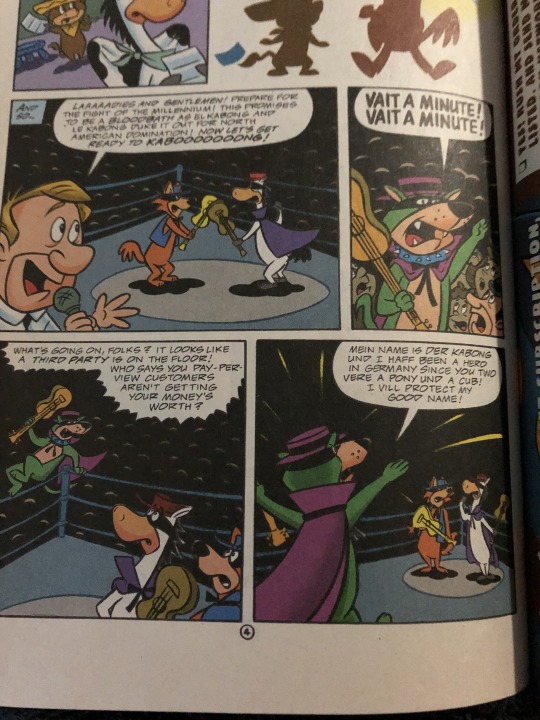
So we’re about to get a WWE (or I guess WWF. Or maybe WCW?) match, until a new challenger approaches, with a German vigilante jumping in.

And then many more. This switches from wrestling to Super Smash Bros to a full on battle royale of the localized knock-offs. Which I won’t lie, it’s a pretty funny idea.

Luckily, what’s a Kabong without a trusty sidekick to save the day? A few of them attempt to team up to find a way to put a stop to this, including one who looks like Boo Boo with Yogi’s hat and Johnny Bravo’s glasses.
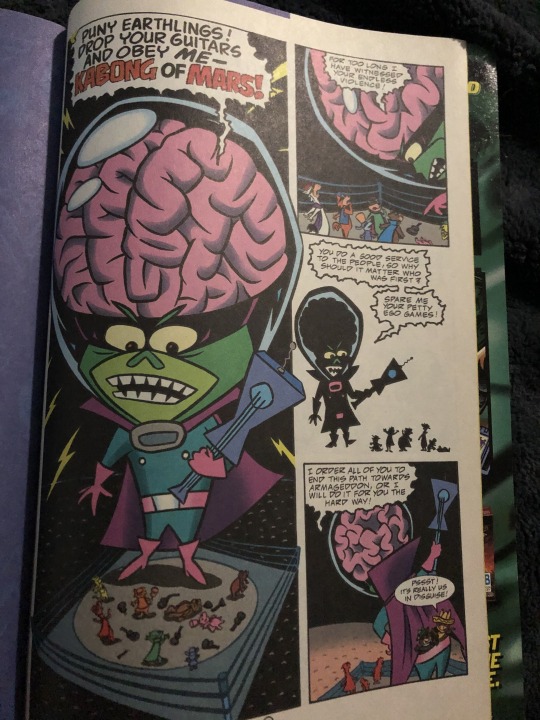
So it ends with the Kabong from Mars (no Spiders) threatening all of the puny humans to stop their shenanigans, and go back to their duties. Which hey, it works! And the story ends with Quick Draw attempting to turn the ten million pesos El Kabong received at the beginning from saving the day into cash. Except pesos are basically useless, which is funny haha right?
This reads like a Hanna-Barbera writer from the 90′s attempting to write a classic character in the present day, and mostly works alright. This does show off one problem with Quick Draw though, that its take on Hispanic culture during the period of the Wild West is problematic. Baba Looey for instance has an exaggerated voice, and he probably needs an overhaul to work today (how did that work in Jellystone btw? I still need to see it). And unfortunately, this point in the late 90′s isn’t all that much more sympathetic to Hispanic culture, as their take mostly stays the same.
But away from that, it’s pretty funny. I do really like Quick Draw when it focuses on how pathetic he is as a supposed hero, either with or without the El Kabong persona.
But I wouldn’t have known if this was in if I didn’t pick up the book. I do understand why Cow & Chicken was the main attraction- *insert Malcolm in the Middle “future is now, old man” img here*- but part of the appeal of Cartoon Network at the time was the mix of old and new school. It wasn’t uncommon to see a classic like Quick Draw next to a modern fav like Cow & Chicken.

But oh well, let’s finish this up. The letters column features a 12 year old offering some of his cartoon ideas- I hope John made it; another boy named John who offers a cute drawing of Space Ghost, and asks about Jan, Jase, and Blip, while insulting the latter, which the editor is not here for; and another boy asking if there are plans for stories featuring 2 Stupid Dogs or Secret Squirrel, as well as hopes for a Cow & Chicken comic. The editor shoots down 2 Stupid Dogs happening, and to be fair, I don’t believe that ever happens. Classic cartoons from 40 years earlier? Sure. Something that ended about five years earlier? Old news. But I do believe Secret Squirrel does show up at some point.
The editor then bemoans how no girls brought in letters this month, and offers a preview of the next issue, which involves Wacky Races. And guess what, I have that one too!

The issue proper ends with an editorial about the importance of recycling, which is fine and all, but my reaction to reading this was “blahblahblah put on more cartoons”
Not bad! Oh, and one more thing of note.

I know, I know, they’re the enemy, and I was all over CN at this point, but I have memories of this promotion. Even though I believe it was long over at this point, and Alex Mack should have aired its last episodes before this issue hit stands.
Here’s an ad! And now it’s in your head. Sorry/you’re welcome!
8 notes
·
View notes
Text
Joseph Brodsky: to translate is to exist

The poet lives in his poems and only through these he can assert his own existence; the poet can be oppressed, censored, encaged, also killed, but until he can write, until there’s someone who reads his poem, he will go on living, he will be free despite all. Deported poets, exiled poets, poets oppressed by a dominant and colonial culture, but still poets, although they have lost their language. And as it’s possible to lose a language, it’s possible to find a new one to tell about the self in verses; this was well-known to Joseph Brodsky, a Russian poet and author, moved to the USA because he was condemned for parasitism and for a cultural environment more and more saturated with hostility and suspicion which censored and hinder the publication of his poems, shut his poetical voice through editorial obstructionism, denied his existence as an author, and thus also as human.
Brodsky’s verses didn’t officially exist in the Soviet Union (but read clandestinely and published via samizdat), so he didn’t exist himself as poet, as man and to exist, he had to make the hardest of the choice: leaving his home country, his native language, denying it because this language refused his creative soul. He left Russia after he was compelled by the regime, he moved abroad and reaching the USA, a Country completely different from the Soviet Union, too much free, too much noisy, but perfect for Brodsky’s poetry. There he translated his rhymes in English and his works were officially published, there Brodsky exists, there his art is loved. There’s no way to oppress the voice of a poet, because it will always find a way to speak, as well as self-translation, instruments of poetic (and cultural) resistance, as well as changing the language, the Country, traditions. Also forgoing himself.
Self-Translation is when author and translator are the same person, when an author translate his/her own literary work. As it happens in translation, there’s an original and a translation, or there’s no translation (when the author chooses to write in a language different from his/ native ones, a behaviour that in very common among colonial and post-colonial writers). The Self-Translator is a bilingual and, often, bicultural (because he/she is an immigrant or a child of immigrants, lives between frontiers or in a former colonised country). On the contrary to a translator, the author who chooses to translate him/herself has access to the original intention (i.e. now and why the author chooses to write a certain expression and the original meaning), original cultural context or literary intertext. This possibility has, however, some limits: the famous psychoanalyst Carl Jung explained that neither the author is completely omniscient (aware of what he wrote in the past) and «[…] have to read it again and may not even completely understand their own motivation for choosing certain passages, certain examples or a certain style»[1]. The most famous authors who translated their own works were Samuel Beckett (from English to French and German, and vice versa) and Vladimir Nabokov (from Russia to French, and vice versa).
What are the types of Self-Translation?
Michaël Oustinof identified three types of Self-Translation:
1. Naturalising Translation (naturalisante): when an author gives priority to the characteristics of the target language (that is that language a text will be translates into).
2. Decentralised Translation (décentrée): when an author introduces in the target language foreign elements that belong to the source language (that’s the language a text is written in).
3. (Re)Creating Translation((re)créatrice): when an author translate and change his/her literary work (or omit some parts) in order to adapt the text to both the target language and culture.
Who are the authors that translate themselves?
1. Bilingual (or polyglot) authors who wants to expanse their audience or just experimenting. Usually, there’s a relation of symmetry between the source and the target language (e.g. French and English). It’s the case of Samuel Beckett.
2. People who speak minority language but choose to write with a dominant language. It’s the case of Luigi Pirandello who translated his plays in Italian from Sicilian dialects.
3. Colonial or post-colonial author who write both in their native language and colonial language.
4. Exiled or emigrant authors who write in the language of the Country they moved to. It’s the case of the Russian Vladimir Nabokov who, after moving to France, started writing books in French (such as his famous novel “Lolita”) and the same Joseph Brodsky.
The case of Brodsky and other Russian emigrée is a unique case of self-translation. Usually, who translate theirselves are those authors living in a condition of colonialism, i.e. they’re from a colonised from another of more prestige and political and cultural power, consequently their native languages becomes hegemonic to the language spoken by the colonists; the authors who live this kind of experience chose to translate their literary pieces to the dominant language, that is the colonist one, so that their work can emerge from a state of oppression, then reaching a larger number of readers and settling their existence as a creative and make raise their culture from the barriers of the dominant one and speak to the colonists through that; so, we’re talking about a form of cultural resistance.
Emigrant Russian authors didn’t choose to translate their world into the language of the Country which welcomed them, because their native culture weren’t oppressed, but because they were oppressed by their own culture; their works were usually divergent from the aesthetic ideals of the regime, thus they were censored or the official publishing was denied (and, often, neither by Russian magazines abroad); to survive as writers and giving life to their literary pieces, most of these authors chose to translate themselves. This kind of self-translation is, in this case, symmetrical, according to Rainier Grutman, because Russian and Western languages have got the same literary prestige, and the bilinguism here is exogenous (always according to Grutman’s definition) because these languages (especially about the relation between Russians and English) have never shared the same geographical spaces.
What pushed Joseph Brodsky to leave his home country and starting a new life and a new poetic and translating in the USA was the accuse and the arrest for parasitism, happened in 1964 (for which Brodsky was interned in the psychiatric hospital of Moscow and after deported and condemned to the forced labour near Arkhangelsk, on the extreme North of Russia). Thanks to his fame, he was freed in the November 1965 after a petition signed by Russian and foreigner colleagues but for the Party Brodsky was a hostile figure to the regime; in fact, when we requested a permission to go abroad, after he was invited by Robert Lowell to attend the International Festival of Poetry in London, «the Union of Soviet Writers answered there were no poet with that name in Russia: he was crossed out from the official list of Russian writers»[2]; they denied him the right of writing, the natural right to proclaimed himself poet and for a real poet this means denying his life, denying his dignity. Refusing his poetry is to refuse him and thus happened when, in 1972, he was commanded to leave the Soviet Union; that means he was not welcomed by his move country, his Russia, his Russian any longer. So, what can a poet do? Brodsky remembers: «on 10th May 1972 I was called out and they told me:”Take advantage of one of the invitation people make to you to leave for Israel. We prepare a visa for you in two days”. “But I don’t want to take advantage of”. “So, prepare for the worst”. I couldn’t do anything but to give up: I managed to make the gems prolonged to 10th June (“after this date, you’re going to have no identity card, absolutely nothing”): I wanted to pass until my 33rd birthdays with my parent in Leningrad, the last one. When they gave me the expat visa, they make me jump the line: there were many Jews waiting days and night for the visa who looked at me astonished, envying me […]. I past the last night in the USSR writing a letter to Brezhnev. The following day I was in Vienna»[3]. He was in Vienna when he met the English poet Brodsky loved most, Wystan Auden, with whom he attended the International Festival of Poetry in London, event that allowed him to meet other authors from the literary Anglo-Saxon world, such as Robert Lowell, but he already left Vienna to move to the US in the July of the same year: he was offered to work to the University of Michigan (where he taught until to 1980). Thus began one of the most important phase of Brodsky’s work and his path to self-translation, which allowed him to reborn as a man and a poet. He lost his language, his Country, but he found a new language through which thinking, loving, writing, through which expressing himself, through which existing. To write is to exist.
Translating ourselves to exist, translating as that our own work to overcome national and cultural borders, to destroy linguistic barriers, to annihilate the borders. «Civilization is the sum of total of different cultures animated by a common spiritual numerator and its main vehicle – speaking both metaphorically and literally – is translation. The wandering of a Greek portico into the latitude of tundra is translation»[4]. Translation is what allows us to converse with other cultures, with the Other, and the translator is, thus, a cultural mediator that lays between two interlocutors and help them to understand each other, not only linguistically, but also culturally, that let bonds between values, norms and beliefs be understandable to who doesn’t know them. Brodsky gave new life to his poems, already oppressed by the hostility of Soviet regime, and he gave the, new social coordinates, although he destroyed the grammar, i.e. the foundation of English language in order to adapt this language to the linguistic malleability of Russian, in order to everything, the intrinsic structure and so the semantic built by that could persist. «Brodsky […] insisted strongly on a mimetic translation i.e. a translation which would retain a poem’s verse structure – especially its rhymes, verse metre, rhyme patterns and stanzaic design should be preserved above all»[5].
A mimetic translation, them, which doesn’t break the architecture of poetry and it fits, as well, the presence of Russian soul in the English language and so the in grammar and morphosyntax, that comes from Pushkinian tradition, according to the form and the content corresponding and so, none of them should be sacrificed in the translation. A tradition enhanced by the Acmeists (such as Anna Akhmatova and Osip Mandelshtam), from whom Brodsky took inspiration. According to the Acmeists, in translation, must be preserved the number of lines, verse metre, rhyme patterns, types of enjambements, rhyme types, linguistic register, types of metaphor, special devices and changes of tone. Following this tradition Brodsky translated his poems from Russian into English, though transforming and upsetting the target language, though drowning bitter criticisms for that which will be have called “Englishness”. Upsetting the language in order to appear himself as a poet, as a Russia. His soul must have to emerge, if he wanted to live through poetry, and the only way to do it, in this case, is to annihilate the rule of the other language, a language chosen to survive. This foreigner who transformed a language that is not his to make it an instruments of resistance, an instruments of existence.
The harshest criticism towards his English was from the British School, which blames Brodsky of transforming the language to make it adapt to his needs; a criticism that hide the will to protect the integrity of the language from an “intruder” like the Russian Brodsky. Despite all, the poet received much esteem, especially from the American School which appreciated his experimenting with the language. Experimentalism due to the dissatisfaction of English translation to Russian poems that Brodsky criticized because they were not capable to keep the complex morphosyntactic structure of the poetic of Russian language. He wrote about it: «Translation from Russian into English is one of the most horrendous mindbenders. There aren’t all that many minds equal to this. Even a good, talented, brilliant poet who intuitively understands the task is incapable of restoring a Russian poem in English. The English language simply doesn’t have those moves. The translator is tied grammatically, structurally»[6].
Even though his approach which was very little conform to modern translation theories, even though we can blame him to have turned upside-down the English and so we can speak of Englishness in his poems, Brodsky «[…] approached his translation with a fervour verging on the quixotic, squaring the circle of poetic translation, defying the spell of impossibility and bridging single-handedly the linguistic gap with great energy» [7].
Viviana Rizzo
Notes
1. AA.VV., Handbook of Translation Studies, edited by Yves Gambier e Luc van Doorslaer Amsterdam, John Benjamins Publishing Company, 2010, p. 306
2. «L'Unione degli Scrittori Sovietici rispose che non c'era nessun poeta con quel nome in Russia: era stato depennato dalla lista ufficiale degli scrittori russi», in CONDELLO, Anna, “Iosif Brodskij: una biografia intellettuale”, in Russian Echo, web (http://www.russianecho.net/contributi/speciali/brodskij/bio.html retrieved in 28th May 2021)
3. «Il 10 maggio 1972 mi chiamano e mi dicono: "Approfitti subito di uno dei tanti inviti che le vengono per emigrare in Israele e parta. Le prepariamo il visto in due giorni". "Ma non ho nessuna intenzione di approfittarne". "E allora si prepari al peggio". Non potevo far altro che cedere: sono riuscito al massimo a farmi prolungare i termini fino al 10 giugno ("dopo questa data non ha più carta d’identità , non ha più niente"): volevo almeno passare a Leningrado il mio trentaduesimo compleanno, con i miei genitori, l'ultimo. Quando mi hanno consegnato il visto d'espatrio, mi hanno fatto saltare la fila: c'erano tanti ebrei che aspettavano, che bivaccavano là in anticamera giorni e giorni in attesa del visto e che mi guardavano esterrefatti, con invidia [...]. L'ultima notte in Urss l'ho passata scrivendo una lettera a Breznev. Il giorno dopo ero a Vienna», in CONDELLO, Anna, “Iosif Brodskij: una biografia intellettuale”, in Russian Echo, web (http://www.russianecho.net/contributi/speciali/brodskij/bio.html retrieved in 28th May 2021)
4. BRODSKIJ, Iosif, “The Child of Civilization”, Less than one, London, Penguin, 1986, p. 139, cit. in ISHOV, Zakhar, “Posthorse of Civilisation”: Joseph Brodsky translating Joseph Brodsky. Towards a New Theory of Russian-English Poetry Translation, Berlin, Freien Universität Berlin, 2008, p. 2
5. ISHOV, Zakhar, “Posthorse of Civilisation”: Joseph Brodsky translating Joseph Brodsky. Towards a New Theory of Russian-English Poetry Translation, p. 4
6. SOLKOV, Solomon, Conversations with Joseph Brodsky, New York, The Free Press, 1998, p. 86, cit. in ISHOV, Zakhar, “Posthorse of Civilisation”: Joseph Brodsky translating Joseph Brodsky. Towards a New Theory of Russian-English Poetry Translation, p. 5
7. ISHOV, Zakhar, “Posthorse of Civilisation”: Joseph Brodsky translating Joseph Brodsky. Towards a New Theory of Russian-English Poetry Translation, p. 3
Sources
1. COCCO, Simona, “Lost in (Self-)Translation? Riflessioni sull’autotraduzione”, in AA.VV. , Lost in Translation. Testi e culture allo specchio, vol. 6 (2009), pp. 103-112
2. GRUTMAN, Rainier, “Beckett and Beyond. Putting Self-Translation in Perspective”, in Orbus Litterarum, n. 68, vol. 3 (2013), pp. 188-2016
3. GRUTMAN Rainier, VAN BOLDEREN Trish, “Self-Translation”, in A Companion to Translation Studies, edited by Sandra Bermann and Catherine Porter, New Jersey, John Wiley & Sons, Ltd., 2014, pp. 323-332
4. ISHOV, Zakhar, “Post-horse of Civilisation”: Joseph Brodsky translating Joseph Brodsky. Towards a Mew Theory of Russian-English Poetry Translation, Berlin, Freien Universität Berlin, 2008
5. MONTINI, Chiara, “Self-Translation”, in Handbook of Translation Studies, edited by Yves Gambier and Luc van Doorslaer, Amsterdam/Philadelphia, John Benjamins Publishing Company, 2010, pp. 307-308
6. WARNER, Adrian, “The poetics of displacement: Self-Translation among contemporary Russian-American poets”, in Translation Studies, vol. 11. N. 2, 2018, pp. 122-138
#Joseph Brodsky#self-translation#translation#Russian Literature#Cintemporary Russian Literature#literature as resistance#translation studies#literature#USA#USSR#Soviet Union#Russia#politics#culture#regime#dictatorship#migration#writing#blogging
21 notes
·
View notes
Text
Fashion Editorial Special: Audrey Bourgeois
Inspired by this post link by @purrincess-chat
Lila put herself out there in the public domain, and just because Marinette’s class and teachers might be stupid enough to fall for her lies, doesn’t mean that there aren’t adults out there who are...
The question was who? Who is critical and vicious enough to do so and has a HUGE audience to say things to, and who works closely with the modeling and fashion worlds and actually knows what they’re talking about...?
Why! Madame Audrey Bourgeois! The Queen of Fashion herself. So please put on your best Devil Wears Prada reading hats on and enjoy as Audrey takes no prisoners.
------------
“Gabriel Agreste Losing His Mind and Sense of Taste”
By Audrey Bourgeois
Published: 9/15/20XX
It is no secret in the fashion world that since the mysterious disappearance of Emilie Agreste, famous Parisian actress, model, and wife of Gabriel Agreste—the man who had single handedly built the Gabriel brand from the ground up—the once envied designer had shut himself away from the world. Living the life of a recluse and refusing nearly any physical human interaction.
That is not to say that the man had lost his ability to design and to run his business, he just now does it all from the Agreste Manor in Paris, France. According to sources he now mostly conducts business meetings via videoconference calls and oversees the employees of this fashion empire via his ever-present and faithful assistant, Nathalie Sancoeur. It was not until a little over a year after the disappearance of his beloved wife that Gabriel Agreste, at last, decided to grace the world with his presence. Appearing, for the first time in public, at the Gabriel Spring Fashion Show, where his own teenage son and Paris heartthrob, Adrien Agreste (age 15), was walking the catwalk modeling one of the newest spring suits and featuring a stylish bowler hat, designed by a talented and young up-in-coming designer, Marinette Dupain-Cheng (age 14).
Despite certain incidents that occurred on that day. Part of which was caused by the gross oversight Gabriel Agreste (a first sign to be sure). The show could still be considered a success and did showcase to the rest of the fashion world that Gabriel Agreste’s talent and designing abilities still reigned supreme and are still a force to be reckoned with, regardless of any personal issues he may be facing in private.
It seemed as if Gabriel was making small steps towards the acceptance in his single life.
Turns out this one moment of public interaction may have been the first cry for help.
His latest decisions in regards to just WHO represents his brand have been nothing but questionable and completely and ridiculous, utterly ridiculous.
This past season Gabriel had introduced a new face to its teen fashion line. One Lila Rossi (age 15).
At first it seemed as if this was simply a pity shoot for one of Adrien Agreste’s little schoolmates, as they both attend the same school and are in the same class.
But, alas, this was tragically not the case.
Despite her clear lack of ascetic taste, especially when it came to her own hair. Really, someone should tell that poor child that hanging two sausages on both sides of her face not onlyfails to come across as ‘trendy’ but it sends an ENTIRELY different message.
I’m both surprised and appalled her mother would leave the house with that style.
I certainly would never allow my own child to been seen like that in public.
Unfortunately, that first shoot was only the beginning as Ms. Rossi has appeared alongside fellow model, Adrien, in three more shoots and a commercial that pathetically tries, and monumentally fails, in portraying them as a young couple in love.
I have worked in fashion long enough to be able to spot what works and what does NOT a merely a glance. But one does not even need to be an INTERN to recognize that the dynamics between Adrien Agreste and Lila Rossi is so utterly ridiculous to the point a shutter of nausea courses through one’s body.
While Adrien continues to hold his own in the modeling world, despite the large shadows that both his parents cast, he is able to shine on his own merit and truly does have the looks and talent to model and act (no doubt traits he inherited from his mother). The same cannot be said for Lila Rossi.
Lila Rossi’s whole look (if you can call it that) is simply not genuine. I have worked in this industry long enough to be able to tell the diamonds apart from the rhinestones. Lila Rossi may want for people to believe that she is a diamond, but she is, without a doubt a rhinestone. Cheap, easy to produce, and a one in a billion find. Oh, sure she may have charm and charisma to carry some solo stock picture photo shoots but in order to make it in the Fashion World one requires to have a certain light and spark that stands on its own.
To put it simply, this girl has no discernable personality. Her expressions are stagnant, as if she had to practice being human, her posing leads me to believe she is merely trying to look good for the camera instead of working to display the clothing and products in their best light, and she has close to no versatility in any of the photo-shoots she has done as all of her pictures can be simply described as her in different outfits but using the exact same four expressions over and over again.
When I say the same expressions, I mean—THE EXACT SAME.
The Sophia robot emotes more human emotion than Rossi.
It is Adrien who carries the shoots and is doing the lion shares of the work while Lila Rossi does her best to APPEAR like a model. To put it simply—she is NOT.
Her hair is just one issue, but it her overall presence that just scream ‘Fake’.
A picture is worth a thousand words, and unfortunately, there are many pictures to choose from.
In the very first photo-shoot that was done with Adrien as her co-model you can easily see the disparity between the two. While Ms. Rossi seems more than happy to be in a loving embrace by one of Paris’ most eligible young bachelors, the same cannot be said for the young Agreste heir. There is an obvious tension in his body language that does not show in any of his other photo-shoots, including ones where he and another model were portraying romantic feelings for those ads. The untrained eye can see the slight curve of his spine, as if he wishes to get away but can’t, the small tension in his smile that screams, “I don’t want to be here but I have a job to do”.
My final verdict to the latest photo-shoot from the Gabriel name, that once more featured Adrien Agreste and Liar Rossi, was that is was ridiculous, completely and utterly ridiculous!
Inside sources on location where the two teens have modeled have also confirmed that there does not seem to be any natural chemistry between them and that Adrien had picked up a habit of making himself scarce until he is needed. Other sources verify that Lila Rossi seems to cling to him as much as possible. Perhaps, in the hopes that someone will confirm her own pathetic delusions of the possibly budding relationship between the two of them?
And my does this girl have a number of delusions.
Not counting the one where she THINKS she can model.
According to several interviews that this girl has given to the sub-par tabloid blog, TheLadyblog, she claims to be the best friend of the Parisian super-heroine, Ladybug. Claims to have connections to multiple high-profile celebrities such as Jagged Stone and Clara Nightingale. Going as far as to claim that Jagged Stone even wrote a song about her. Lets ignore the legal implications of a man in his early thirties writing a song about a child for a second and continue examining more of said child’s claims.
According to another interview she gave on the same trashy blog, she claimed to be involved in multiple charitable organizations and causes, citing different projects that she has ‘supposedly’ helped with and oh so humbly placed most of the successes of those projects on her shoulders.
An official statement from Gabriel has stated that the girl has multiple health issues as well and is an inspiration on her abilities to overcome those obstacles in order to model and her other so-called various charitable actions. Very, well we won’t pry into a minor’s personal health.
Her public life, however, now that she is in the public domain is fair game.
It did not take even twenty minutes of searching to find absolutely NO validity to any of her claims.
Her claims of being a close personal friend of Ladybug: FALSE
- The timeline does not match her arrival to Paris with her family. Nor does allow for ample time to establish any sort of close friendship.
- Ladybug herself has the sense to never reveal anything about her personal life, but a little nobody is more than happy to broadcast their ‘supposed’ friendship on a blog that could once claim to be the best source for information on Paris’ two heroes? I think not.
- Eyewitnesses from when the girl was Akumatized into Chameleon and subsequently defeated on the Eiffel Tower stated that Lila Rossi seemed to hold animosity towards the red clad heroine.
- Ladybug has made no statements in knowing Lila Rossi and there has been no photo documentation of the two seen together, even though Ladybug can be seen almost daily swinging around and running along Paris’ rooftops with Chat Noir.
Her claims about Jagged Stone writing a song about her because she saved his kitten on airport runway: FALSE
- Jagged Stone has never owned a kitten according to his personal assistant, Penny Rolling, and his exclusive interview with La Mode three years ago that revealed that the only pet he ever had other than his current pet crocodile, Fang, was a dog as a child in the States.
- A quick Internet search also reveals that Jagged Stone and Lila Rossi have never even been in the same country together until four months ago. The rock star was still on tour in America while Ms. Rossi was in Paris, France. The date of the Ladybloginterview is time stamped long before then.
Her claims to helping inspire and help co-write Clara Nightingale’s last album: FALSE
- Countless interviews with the pop singer, and official statements upon the release of her album, Heart of Gold, will reveal that the inspiration for said album was her grandmother in her native home country of Brazil.
- This was also the first album that Clara had written completely on her own in order to establish her own unique flair.
- I personally reached out to Clara herself and confirmed that she has never, met or even HEARD of a Lila Rossi. Strange? One would think that such collaboration would ensure that one of the parties involved would at least remember the other’s name?
Her claims to travel with Prince Ali of the Kingdom of Achu for environmental charitable work: FALSE
- Again, a quick Internet search of the Prince’s official website and bio lists all of the organizations he is involved with. All of which focus primarily on children such as the International Coalition for Equal Opportunities, the World Health Organizations vaccinations drive, and the Refugee Children’s Fund to name a few.
- A quick call to the royal family’s publicity affairs office confirmed that Prince Ali had never been in contact with Lila Rossi and are now looking into the matter for themselves. After all, an unknown person cozying themselves up to the second in line to the throne is matter of GREAT interest to the Royal Head of Security.
Her other claims of travel to international destinations in the middle of the school year: FALSE
- According to the Italian Embassy’s official website Mademoiselle Maria Rossi had been stationed in Paris since her arrival almost a year ago and has not left the country, other than for a few short trips back to Italy to visit family members.
Her claims in having trained in gymnastics, ballet, and figure skating and even going so far as medal in gold in all three at major competitions in Italy: FALSE
- Again, a quick Internet search reveals all winners of the top twenty major competitions in Italy for the past fifteen years. Names, age, date, and location of the competitions are easily and readily available to the public. NOTHING about Lila Rossi winning gold in any sort of athletic competition.
Her claims of being invited to have tea with her Royal Majesty, the Queen of England: FALSE
- Any and all of the Queen o England’s engagements are public records as well as very well documented. Surprise, surprise there is NOTHING about a Lila Rossi mentioned in any credible new source, or even a single tabloid blurb. The only thing to sustain such a claim is the word a child who actually believes that her jacket looks good in light of day.
Honestly, I could go on and on and even be able to write a whole book. This girl has told so many tall tales she makes elected officials seem honest.
So let this be clear to the world of Fashion.
Lila Rossi is nothing more than a liar.
A liar who had only as gotten as far as she did because she was lucky enough to find someone with a decent online following that was both gullible and stupid enough to post those interviews online without ever once providing additional sources to verify them or double checking those claims. It was not that difficult disclaim every single one of those interviews.
I timed myself and it did not even take me my lunch break to do so.
The very fact that this girl is supposed to be the lead female teen face of Gabriel makes me question Gabriel Agreste’s sanity. Does he honestly think that having Rossi represent his brand is the smartest thing to do?
There clearly must be something in the water in Paris if Gabriel Agreste had not even bother to run a simple background check on the girl in order to ensure that there were no skeletons in the closet that would haunt his brand. Turns out she did not have any, but she sure did purposely create them.
I have to congratulate Monsieur Agreste on this achievement though.
Never have I seen the credibility of a designer go from as set in stone, to as questionable as a ‘designer gown’ bought in a Sale-Mart so quickly. What other decisions is he making behind the scenes that will further clue us in to his mental decline. Will the next Gabriel Show feature plaid parachute pants with matching toucan bird print dress shirts?
Yes, it seems as though grief has finally come to claim another once brilliant designer if he is unable to see past the paper-thin façade that Lila Rossi believes will be able to get her through this world. All the signs are there in same hideous orange Rossi insists on wearing.
Clue number one should have been her clear lack of any substance, versatility, and talent after the first photo-shoot she appeared in. The transparent aversion his own son has shown towards a fellow classmate should have been clue number two. And finally, clue number three should have been that this girls climb to fame was all due to a tabloid blog, TheLadyblog, run by the amateur journalist of all amateurs journalists that could not even be bothered to check their sources.
Or Google for that matter…
Gabriel has been known to take certain risks in the past, but the decision to hire Lila Rossi is nothing more than a mistake.
For the sake of all of our ocular senses, both Gabriel Agreste and Lila Rossi are clearly in need of psychiatric help.
The sooner, the better.
-----
Yay, nay? What did you guys think of this little Fashion Editorial by the Queen of Fashion of the Miraculous universe. Any thoughts. This was just so much fun to write I am so doing a follow-up to this.
#Queen of Fashion#audrey bourgeois#ml spite fic#ml salt fic#miraculous ladybug fic#miraculous salt#miraculous salt fic#lila rossi salt#lila rossi#Lila sucks#Fashion Editorial#miraculous fashion#Fashion Editorial Special: Audrey Bourgeois#Audrey is taking no prisoners#Gabriel Agreste#Gabriel Agreste spite fic#Gabriel Agreste salt
4K notes
·
View notes
Photo
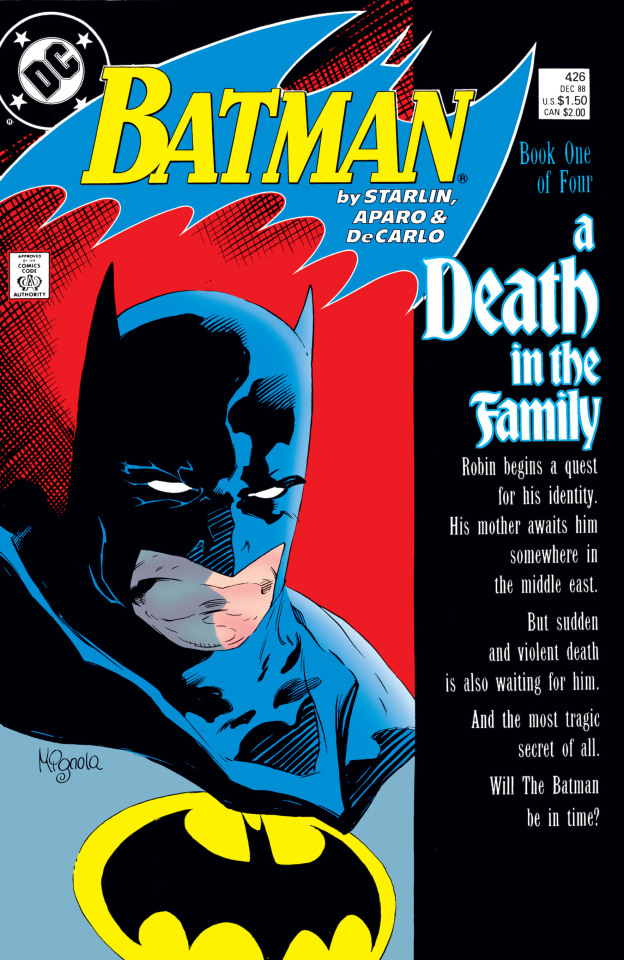



BATMAN: A DEATH IN THE FAMILY
BATMAN #426-429
DECEMBER 1988 - JANUARY 1989
BY JIM STARLIN, JIM APARO, MIKE DECARLO, ADRIENNE ROY, MIKE MIGNOLA, ANTHONY TOLLIN AND OVER 10,000 PHONE CALLS.

Jason Todd finds out his biological mother may still be alive and he discovers there are three possible women that could be his mother. He then decides to meet each other to find out which one is the one. But at the same time, the Joker escapes Arkham and decides to make some quick money by dealing with terrorists. Both missions will collide into each other and change Batman’s life forever.
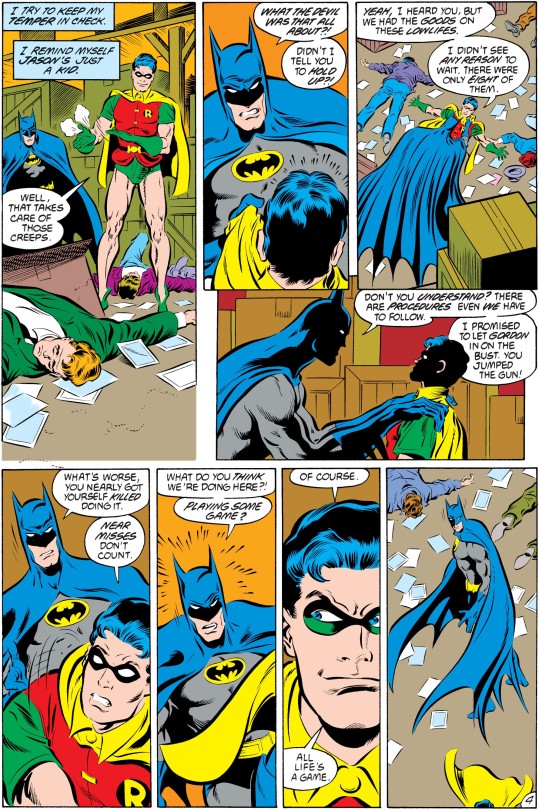
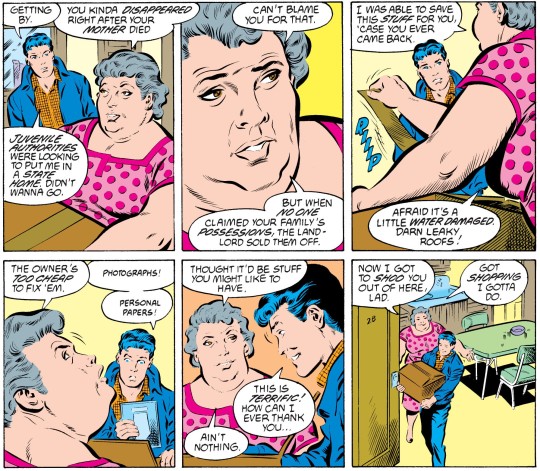
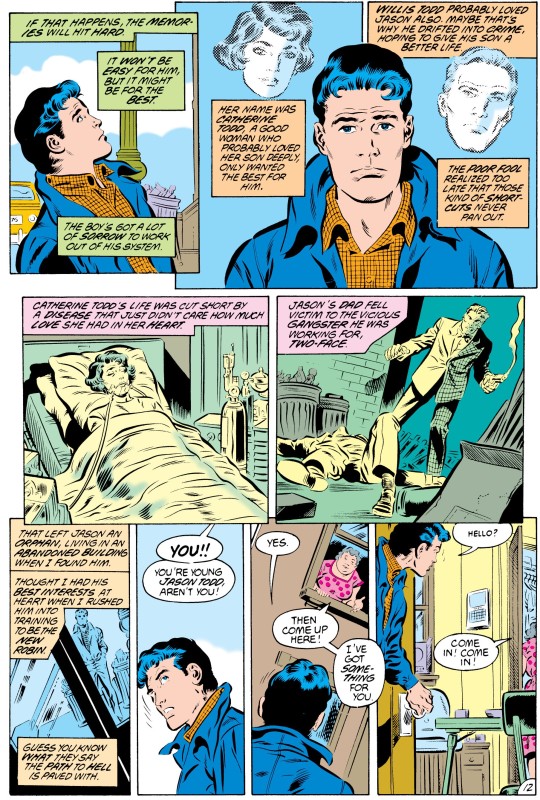


SCORE: 8
This story was a big deal when it came out, and for Batman fans, it still is. But it has been cheapened by DC’s decision to bring the character back from the dead. I assume this is not spoiler, as it is in the covers.
I will talk more about the plot in the spoiler section. I feel like in general there is a lot of lazy writing in this story. I think the idea was good, but there are many things in the story that didn’t need to be this way. I would have just removed everything about the middle east, and I would also tried to find an alternative to yet another “diplomatic immunity” plot.
Jim Aparo did his usual iconic style here, but that also means that many characters look too much alike, which is a shame. Especially when Jason doesn’t really look like a teenager.
So, something I can discuss outside of the spoiler section, is the whole gimmick of this story. The phone number vote.
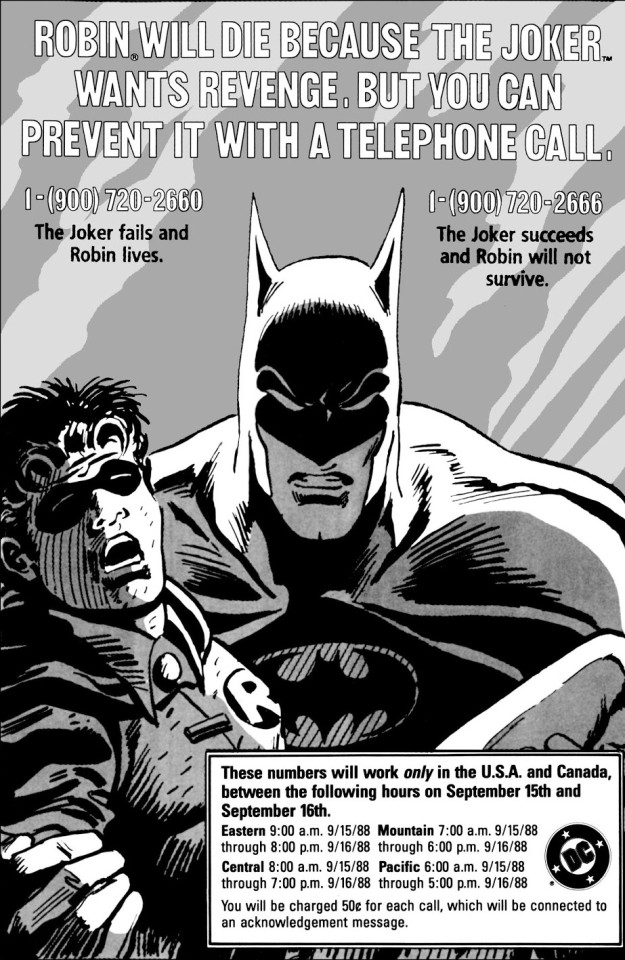
From Wikipedia:
Jason Todd, the second character to take the Robin persona, was introduced in Batman #357 (March 1983). He was initially depicted with a personality and origin identical to that of predecessor Dick Grayson. However, the history-altering events of Crisis on Infinite Earths and Batman: Year One allowed editor Dennis O'Neil, writer Max Allan Collins, and artist Chris Warner to revise his backstory and personality. The changes caused Todd to grow increasingly unpopular with fans during this period; unlike the cheery and optimistic Grayson, this new characterization of Todd was depicted as foul-mouthed, impulsive, and bad-tempered.
Aware of Todd's unpopularity, O'Neil and writer Jim Starlin began discussing ways to retire the character, and before long, began to consider killing him altogether. During an editorial retreat, O'Neil recalled the success of a 1982 segment of Saturday Night Live, in which Eddie Murphy encouraged viewers to call the show if they wanted him to boil Larry the Lobster on air. O'Neil proposed a similar idea involving Todd to publisher Jenette Kahn, who liked the idea. O'Neil would later state:
We didn't want to waste it on anything minor. Whether Firestorm's boots should be red or yellow ... This had to be important. Life or death stuff.
— Dennis O'Neil
On the back of Batman #427, an advertisement was run featuring Batman carrying a severely wounded Robin. In the ad, readers were warned that Robin would die of his injuries "because the Joker wants revenge", but that they could "prevent it with a telephone call". Two 900 numbers were given: one (1-(900) 720-2660) which would let Robin live, and another (1-(900) 720-2666) which would cause him to die. The numbers were active for 36 hours, beginning on September 15, 1988, at 8 A.M. EST and ending on September 16, 1988, at 8 P.M. EST. Readers were charged 50 cents per call. Approximately 10,614 votes were cast during this period. When tallied, the final results were extremely narrow, with 5,343 votes in favor of Jason's death over 5,271 for his survival—a margin of just 72 votes. O'Neil would later admit to having voted in Todd's favor, as he felt that Batman was incomplete without Robin and feared killing Todd would lead to backlash.
"A Death in the Family" was written by Starlin. The artwork was illustrated by Jim Aparo, inked by Mike DeCarlo, and colored by Adrienne Roy. John Costanza handled the lettering, and Mike Mignola designed each issue's cover. The four-part story line began in Batman #426 (December 1988), and concluded in Batman #429 (January 1989). Two versions of issue #428 were prepared: one that would be used if readers voted in favor of Todd's survival, and another to be used if he was to be killed; the latter version ended up being used. The story line was later collected in trade paperback and hardcover form as Batman: A Death in the Family after its conclusion.
When it was first released, "A Death in the Family" generated massive media coverage and backlash over the decision to kill Robin, a beloved comic book character and pop icon. Newspapers such as USA Today and Reuters published articles about it, the latter of which would state that "a group of comic book artists and writers has succeeded in doing what the most fiendish minds of the century... have failed to accomplish". Frank Miller, author of The Dark Knight Returns (1986), was highly critical of the story, describing the "toll-free" number voting as "the most cynical thing [DC] has ever done". O'Neil and his team were caught off-guard by the amount of attention the story drew; according to him, it lasted four straight days, and was unlike anything the team had previously experienced. The story line was a bestseller in both the standard single-issue and trade paperback format.
In retrospect, Hilary Goldstein of IGN called "A Death in the Family" one of the best Batman graphic novels ever written. He described the story as "worth the price of admission", and considered letting readers vote on Todd's fate to be one of DC's strongest decisions. Both Goldstein and NPR contributor Glen Weldon agreed with the choice of killing Todd, as both felt the character was poorly developed and inferior to Grayson. Screen Rant praised Aparo's cover for the collected version, describing it as "iconic" and perfect for showing such a grim, sad moment.

From DC in the 80s:
For Batman, we did Death in the Family -- which was their best-selling book that year -- but it turns out they had all these licensing (pajamas, lunch boxes, and stuff like that) and the licensing department was very mad, everybody got mad, and they needed somebody to blame -- so I got blamed. And within 3 months all of my work dried up - Jim Starlin
Spoilers after the break...
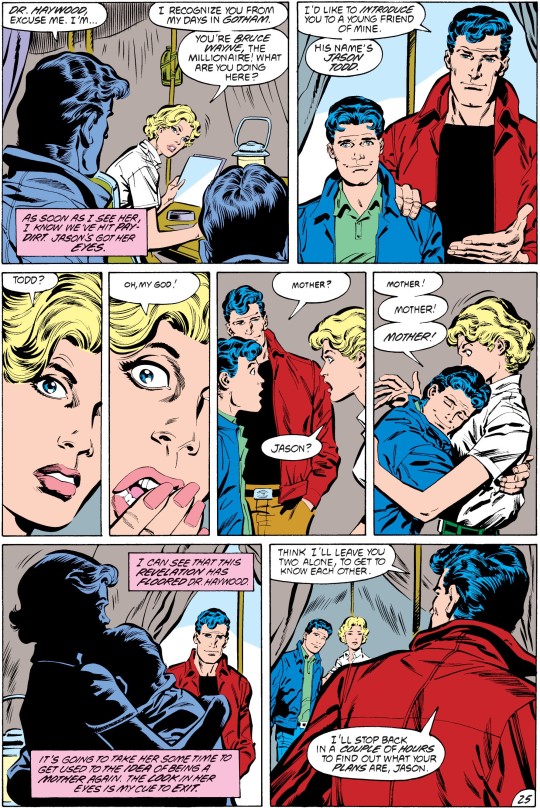

So one of the reason I say there was too much lazy writing in this story, has to do with all the coincidences. The Joker just happens to be in the same places as two of the possible mothers. And not only that, Joker even knew Sheila when she lost her license for doing abortions. I understand why Sheila betrays Jason (she was also taking money from the poor in Ethiopia and didn’t want any problems with the law), but it was never explained how the Joker and Sheila knew each other.
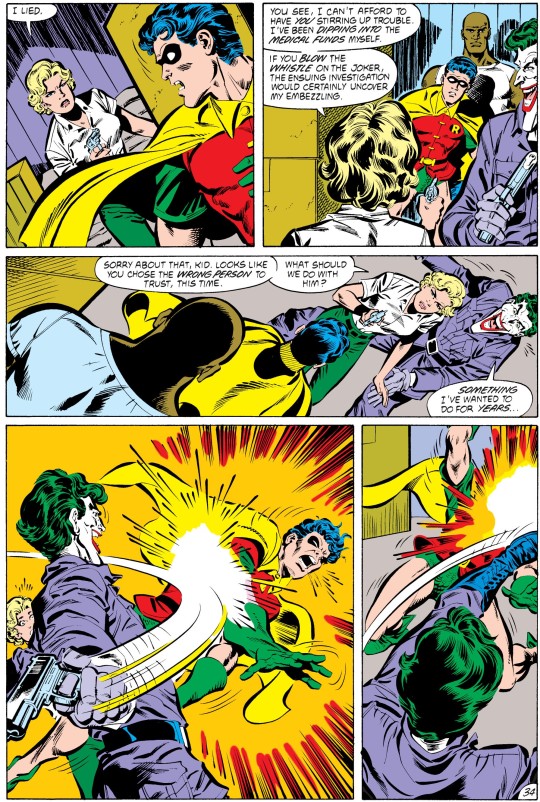
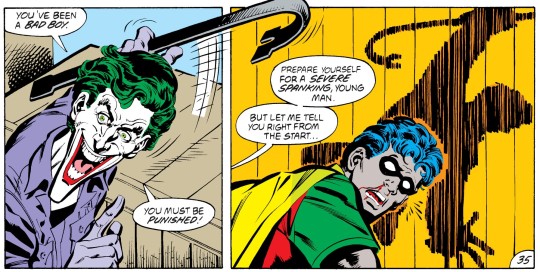


There goes mother of the year!
To be honest, while Jason’s death was brutal, I always felt it was the right thing. Being Robin was child endangerment, Starlin was right in that. But it also seems like Jason magically became Robin, without much thought to it. I tolerate the pre-crisis version more than this one, but the people to blame for how he ended up being... are Max Allan Collins and Jim Starlin.


There were two versions of issue #428, and the material ended up being used for Batman Annual #25 (Infinite Crisis tie-in... more lazy writing, by the way).
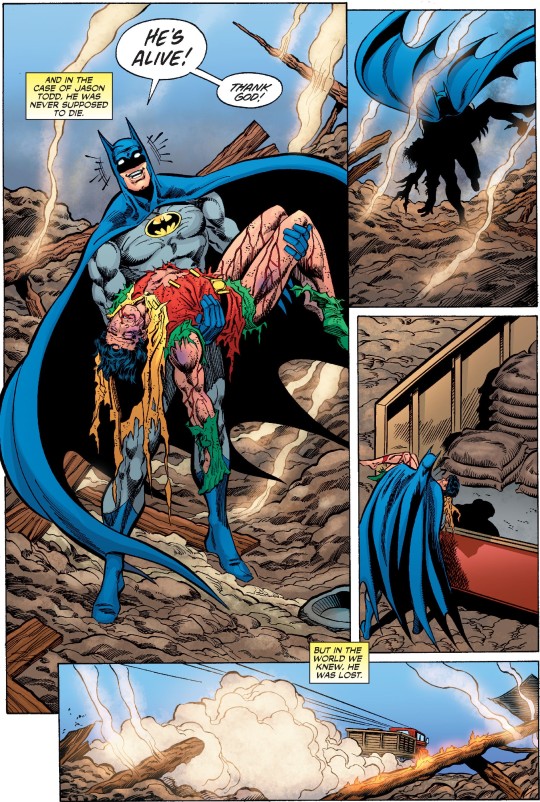
But to me the idea of using diplomatic immunity once again was ridiculous, and just the idea that the Joker would become ambassador and kill everyone in the council... while representing Iran... is also quite stupid, because it would be considered an act of war on all other countries.


There is also another idea happening in the last issue. That the Joker knows who Batman is. This would make sense as it was too much of a coincidence that Jason died in that same explosion (Batman even mentions Jason to the Joker). The issue may have been edited to remove all references from the Joker that he knows who Batman is, you can read more about it here.
Both Joker and Robin would drop off the radar for an entire year, a year that was quite important for the Joker, as the Batman Motion Picture created bat-mania around the world. In fact, I am lying, the Robin concept wouldn’t take long to start resurfacing (in just a few months we would have Batman: Year Three). But the consequences of this story were felt for years, until people at DC started basically publishing fan fiction, with reality-punching Superboy prime.
If I had to vote, I would vote for Jason to die. Mostly because I know now, how much potential him dying gave to the batman and robin mythos. Having that dead Robin there is a reminder that what they do is dangerous and has no place for amateurs. I wouldn’t vote for Jason to die again now, as it wouldn’t mean a thing. Like death in comics.
#mike mignola#jason todd#robin#batman#joker#superman#dc comics#comics#review#1988#1989#modern age#a death in the family#jim aparo
13 notes
·
View notes
Note
Just finished Batman: Hush the animated movie. What are your thoughts on it?
Alright, everyone. Here we go:
Batman: Hush Movie Full review
To begin, as I’ve stated here previously, Batman: Hush is a very important story to me. It was the first Batman comic that I ever read many years ago. In the sixteen years since its original publication it has undergone at least nine different editions and is still one of the most recommended and critically praised Batman stories of the modern era. It was the starting point for many people in the Batman fandom, and I still believe that it is the most pinnacle story regarding Batman and Catwoman’s relationship. The fact that it’s still so influential, nearly twenty years later, in indicative of its importance and merit.
When DC Comics announced last summer that they were officially making Hush into an animated movie I was happy, but I cannot say that I was excited. This was due to unrelated factors that were happening simultaneous to its announcement that obliterated my faith in DC Comics as a whole. You can imagine my dismay when I learned that instead of creating a direct adaptation, in the same vein as Frank Miller’s The Dark Knight Returns and Year One, they would be changing the story to fit in with their current New 52 inspired animated universe.
As anyone whose been following me for a while may have observed; I’m highly critical. I can usually find the good and bad in something and when I’m giving my take on things from my perspective it’s pretty fair and balanced. I was fully aware that the Hush movie made changes to the story and knew going in that I would have to temper my expectations, but I still gave it a chance.
Many will say that the film should be viewed on its own merit, and I generally tend to agree. If not held up to the book the movie is watchable and very easy to enjoy. But it’s an adaptation. An adaptation of one of the best and most popular Batman stories of all time. An ambitious and operatic year long event from Jeph Loeb, and one that I personally hold in the highest regards. Completely divorcing the movie from its source material is unfeasible.
With that said; as I review this movie I will be critiquing as loosely inspiredimagination of the Batman: Hush comic, and only making comparisons to demonstrate potential compromises of the story or the characters.
***Obvious spoilers ahead***
THE GOOD AND THE BAD
After many years of begging, pleading, rumors, and teasing the Batman: Hush animated film was finally released during SDCC weekend. The basic plot remained intact: a mysterious new villain named Hush targets Batman’s crime fighting career as well as his personal life, which is further complicated by his burgeoning romance with Catwoman. While making concessions that range from minor to pivotal the movie manages to be different while maintaining a degree of familiarity. All the most iconic scenes are there in one aspect or another, with only one notable exception; the Jason Todd graveyard scene.
There’s not much to say about the general plot. It for the most part, stays true to the essence of the story, while being different in execution. Most changes were traversable, while others were pointless and baffling. The first questionable change occurs early in the movie, when Catwoman delivers the stolen money to Poison Ivy; Ivy kisses Catwoman, which she does not reciprocate. In the original script for the book, I believe, that Ivy did kiss Catwoman, but Jeph Loeb was told by editorial to remove it, because it was “too much.”
It was clear in the comic book that Ivy was using her powers to mind-control Catwoman. In that context kissing her would have made more sense. In the movie the extent of her influence over Catwoman is unclear. It appears that she is blackmailing Catwoman. Catwoman’s coldness and irritation afterwards implies that she has maintained some degree of self-awareness. Her use of coercion rather than force renders the kiss pointless, and its intention to merely be salacious.
Other needless changes involve swapping out characters. Bane, for some reason, has taken the place of Killer Croc. Damian Wayne has taken the place of Tim Drake, and Amanda Waller makes a token appearance, but both proceed to only have one scene.
As Rick Austin from FortressofSolitude put it:
Some changes to the original story are surface-level questionable, making you wonder why they changed them at all – like substituting Killer Croc for Bane, for instance. Presumably it was done for recognition and name value, and barely has any relevance to the story. Huntress is replaced by Batgirl, probably for the similar reasons, but that’s more important and naturally means Oracle’s role in the story is gone. Slowly but surely, the small tweaks begin to have a big knock-on effect. Important lines of dialogue have been jettisoned, some elements have been removed and some characters replace others just to make this fit with other recent DC animated films.
The movie takes a more action/adventure route rather than a character driven mystery, chugging along at breakneck pace making several plot concessions along the way. What it does manage to improve from the book, as far as a Batman and Catwoman shipper can see, is it beefs up Batman and Catwoman’s ill-fated romance, by way of a montage depicting adorable, if at times out-of-character, domesticity that even involves matching his and hers robes. Its inclusion was more fan-servicey than plot driven, but the ship isn’t doing well right now so I’m not about to complain about that.
What I will complain about isn’t what was added to the romance, but what was excluded from it. The film cuts out all the most important scenes that demonstrate why the dynamics of Batman and Catwoman’s relationship works for them. Yes, we get the rooftop kiss that has graced a thousand screensavers and Batman ultimately making the decision to reveal his identity to Catwoman, but everything in service of Catwoman’s perspective are removed entirely.
The scene from the book when Catwoman admonishes Batman for saving her instead of going after the Joker after she is shot at the opera, is changed to Catwoman merely telling Batman to go after Harley Quinn.

If you ever choose to rescue…me again over catching the bad guy…I swear I’ll scratch your eyes out. I’m not some kid you took in and trained.
This scene is important because this is where Catwoman affirms how she sees herself in this relationship: she is Batman’s equal and she expects– demands– that he treat her as such. These changes seem benign at first, until it becomes clear later why they were made. More on that in a bit.
The original script for Hush also included a tasteful post-coital scene that was ultimately cut by editorial. The scene makes its way back into the movie in lieu of some of the more emotionally intimate moments, like Selina dialoguing with Alfred in the bat-cave. The dialogue also fails to compensate for this. Batman and Catwoman’s pillow talk topic include how Batman used to think Catwoman was a kleptomaniac.
“You were beautiful, intelligent, and brilliant,” he tells her. “I assumed if you were stealing it was because you couldn’t control it.” I see this come up in fandom every now and again, and Catwoman cannot be a kleptomaniac because kleptomania is an impulse control disorder. Catwoman steals for profit and executes elaborate premeditated heists. I can see why other people would make that mistake, but the world’s greatest detective should have more cognizance.
Most of the changes to film are surface-level and trivial, but where the movie majorly fails is when they attempt to fix things that weren’t broken to begin with.
The most major change doesn’t occur until the final act of the movie when it is revealed that Hush is actually the Riddler. At first, I thought this was a misdirect, but no. The Riddler is really Hush and Tommy Elliot was just a plot device, and he is really dead. Like in the book, Riddler gained knowledge of Batman’s identity while in the Lazarus Pit, and decides to take revenge by going after Bruce Wayne’s friends and loved ones.
This change is nonsensical and renders Tommy Elliot’s role in the movie essential meaningless. He is a mere plot device, a shamefully underdeveloped plot device, intended to provide Batman with angst. Villains targeting Batman’s loved ones is all too familiar occurrence, but audiences barely get to know Tommy long enough understand the depths of Batman’s grief and mourning.
As I’m sure all of you are aware at this point that in the book it is revealed that Hush is Tommy Elliot. Substituting Tommy for Riddler diminishes the impact of the reveal and Hush’s motivations. Tommy, Bruce’s close childhood friend, has a personal vendetta against Bruce. He uses his friendship, familiarity, and access to Bruce Wayne to attack him both personally and as Batman. It also complicates Batman’s relationship with Hush as a villain. The Riddler being Hush is just a theatrical Gotham villain pretending to be a different theatrical Gotham villain for no reason whatsoever.
Towards the end of the movie Riddler kidnaps Catwoman and tries to kill her in an elaborate trap. Since Bruce was damseled early in the movie, I didn’t so much mind that they did the same to Catwoman. I like that Batman and Catwoman can depend on each other, and it demonstrates a degree of equality in their relationship. However, while Batman was only incidentally damseled for maybe 60 seconds, Catwoman was subtly threatened with rape for intervening on his behalf and later got the full-on woman-tied-to-railroad-tracks-treatment. Predictably Batman shows up and saves the day.
THE UGLY
Batman: Hush made several missteps that I was willing to overlook, and almost got through its entire 82-minute run time before doing the only thing that I considered truly egregious.
After the ensuing fight the building begins to collapse and Catwoman leaves Riddler to die, after Batman attempts to save him. Batman argues that they could’ve saved Riddler instead of letting him die. Catwoman becomes angry. “You’re crazy! You’re absolutely insane,” she exclaims melodramatically. Batman and Catwoman decide that their moral differences are too stark and break up, but leave the door open for the future.
This is where the movie took an unexpected turn for the worse. This is where the reason why so many changes to Catwoman’s character becomes clear.
Batman goes out as the voice of morality and looks like the hero, and Catwoman is completely thrown under the bus to make it happen.
Early in the movie during the famous battle of Metropolis when Superman is under the influence of Poison Ivy, Catwoman throws Lois Lane off a building to snap him out of the spell. Later when Superman is out of earshot Batman tells Catwoman that throwing Lois off the building was not part of the plan and that he did not approve of her methods. In the book it was Batman’s idea to throw Lois from the building. This moment frequently makes appearances on Worst-Things-Batman-Has-Ever-Done lists on comic sites.
During the opera scene Catwoman attempting to stop Batman from killing the Joker in a fit of rage was also cut. Here it was Batman who was acting morally questionable, and Catwoman was the reasonable and morally righteous one, so to speak.
These, along with Catwoman allowing Riddler to die, are intended to make Catwoman seem like she has a cursory attitude towards killing, when that couldn’t be further from the truth. All of this inevitably shifts all the blame for the relationship not working out on Catwoman. Catwoman’s flaws are irreconcilable while Batman is the blameless voice of reason. This is abominable at best, and sexist at worst.
The book ends similarly and yet profoundly different. Upon the announcement of the film some people were hoping for the ending to be changed to something presumably happier for Bruce and Selina. In the book Batman and Catwoman break up, but under much different circumstances.
I personally feel that the ending to the original was appropriate for the story. Batman sabotages their relationship pushes Catwoman away because he realized was not ready for the vulnerability required in that type of relationship, It ends on a bittersweet note. Batman and Catwoman can have a relationship “someday.” All they need is a little more time, and it’s Batman who need to be a little bit different.
Even as things end Loeb simply and perfectly sums up why Batman and Catwoman work:

We are who we are. That’s why this works.
The film makes fundamental differences, that can only be remedied by Catwoman changing herself, are the root of Batman and Catwoman’s relationship dysfunction.
The changes to Catwoman’s character occur only to justify the ending. The filmmakers went to great lengths to villainize Catwoman to make it seem like it was all her personal shortcomings that ended things instead of Batman’s to make him seem more heroic. It relegates Batman and Catwoman’s relationship to a tool to demonstrate Batman’s inflexible moral code.
To add insult to injury, as Batman and Catwoman’s relationship comes to an end, Selina tells Bruce bitterly that she changed herself to be with him and was willing to continue changing. This robs Selina the agency of having reformed on her own, in a film that has already diminished much of her voice and independence.
It’s almost laughable that Selina once told Huntress that reforming was worthwhile, “as long as you’re doing it for yourself, and not for what someone else thinks of you,” in the same book the movie was based on.

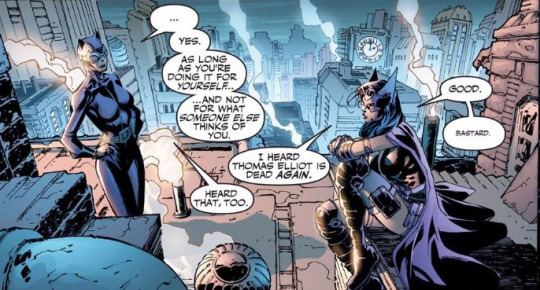
Some dude (and it’s a dude; I checked) read the book, saw this panel, then decided to have her say literally the opposite. I wish I was making this up.
On its own the Batman: Hush movie is watchable. The casual viewer and batcat shippers alike can easily find something to enjoy. But watchable is a low bar to pass when based on one of the most popular Batman stories of our era. What should have been an exceptionally easy recipe for success did not exceed the bare minimum. It’s drab, bland, and dark animation style does not hold up to Jim Lee’s iconic penciling or Scott Williams’ colorful fills. The changes to the story are generally acceptable, until the final act of the movie when things go off the rails.
Ultimately the movie exceptionally fails at capturing the dynamics of Batman and Catwoman’s relationship, trading in much of the depth and intimacy for shower sex and pet names. On its own Batman: Hush stands as a mindlessly entertaining adaptation, loosely inspired by a Batman story of mystery and intrigue. Held up to the source material, it’s a pale and grotesque imitation.
#ask#blackbatpurplecat#batcat#Batman#Catwoman#Bruce Wayne#Selina Kyle#personal note#review#long post#batman hush spoilers
124 notes
·
View notes
Text
Missives of Appalling Idiocy and Envy Embarrassing to Behold
So many messages of the type alluded to by the title of this article crossed my desk in the last fortnight that I found myself in the rare position of having too much content to easily record and communicate with pen and paper—a writer’s dream, if that content did not also simultaneously indicate both the tolling of the proverbial bell, and the fact that I am one of those for whom the death knell sounds.
I have observed the colleges and universities of the Western world devour themselves in a myriad of fatal errors over the last two decades, and take little pleasure in seeing what I knew was inevitably coming manifest itself in an increasingly comprehensive manner. It is of course a self-destructive and unfortunate tendency of human reason, with all its limitations—as well as ego, with all its pretensions—to wish or otherwise agree to serve as Cassandra, and to derive a certain satisfaction in watching the ship whose demise was foretold breach its hull on rocks hidden from all other observers. The self-righteous pleasure of “I told you so,” is, however, of little comfort when the icy water wends its way around ankle, knee and thigh, threatening to swamp everything still retaining its incalculable and unlikely value, even if it simultaneously makes short shrift of the ignorance and willful blindness that is frequently part and parcel of the death of something once great.
It is also necessary to note that the catastrophic failures of process and aim which I am about to relate were by no means hidden from the public view by the persons and institutions in question. They were instead positively trumpeted to all by multiple attempts to harness the powers of social media and announced, more traditionally, in press releases designed to indicate the success of some great and laudable moral striving. It is nothing less than a dire day when the proud revelation of vices of deadly and multifarious seriousness serve to substitute for announcements of genuine and valuable achievement, but that is where we are at—make no mistake about it.
The first story emerges at Brock University, in combination with the scientific journal Angewandte Chemie—the former an educational institution of moderate reputability; the latter a prestigious place of scientific publication among chemists. It is no easy matter to find a permanent tenured faculty position at such a university, or to publish research findings or literature reviews/summaries in a peer-reviewed scientific journal. The process generally requires several years and multiple resubmissions and rounds of editing by a minimum of three colleagues per submission with expertise in the field as well as approval by the editor. Angewandte has a rejection rate of 80%—and it should be noted that that rejection rate only takes into account papers that the submitting researcher felt were of sufficient quality to be considered by a journal of high standards. Dr. Tomas Hudlicky of Brock submitted an essay memorializing and updating a piece written thirty years ago, which has been widely recognized as powerfully influencing the direction of the chemistry subfield in question (organic synthesis).
Now, the first thing that must be understood about Dr. Hudlicky is that he holds a prestigious Canada Research Chair, a position funded by part of a large federal initiative devoting approximately 300 million dollars per year in the attempt to attract to Canada (or to encourage to stay in Canada) researchers who are of particular promise, as evidenced most fundamentally by their research productivity. That promise or productivity, in turn, can be measured with reasonable accuracy with metrics such as number of peer-reviewed articles in relevant scientific journals (more than 400 in Hudlicky’s case), by noting how many times such articles are cited by other authors over the years subsequent to publication (Hudlicky: 13300) and, finally, by a metric known as the h-index, which provides a measure of how many publications have received a variable minimum number of citations (and which therefore combines in a single number some information about publications per se and some about citations). A researcher with an h-index of 10 has published 10 papers with 10 or more citations; a researcher with an h-index of 57 (Hudlicky’s score) has published 57 papers with 57 or more citations. Hudlicky’s research productivity is admirable and rare. The mere fact that he was hired as a Canada Research Chair meant that his department, as well as the federal governmental agency tasked with funding the attraction or retention of extreme talent, both determined in the relatively recent past that he was a fish well worth landing. Something about this needs to be clarified: the universities that hire those researchers competent enough to be competitive in a Canada Research Chair competition are not doing them a favor by offering them a position; rather, it is an honor for the university (and the students, both undergraduate and graduate, that attend the institution) to be chosen by the researcher in question. No serious academic disputes this, although some may quibble about the precise metrics used for identification of the serious talent. This is particularly true of an institution such as Brock, which is an university of reasonable but not exceptional quality, and which genuinely needs highly productive faculty members to help it ratchet itself up the very competitive academic ladder.
Hudlicky’s paper in Angewandte Chemie was peer-reviewed positively, judged as desirable by the relevant editorial staff, and published. This meant that it managed the difficult job of passing through the eye of a needle, and entering the kingdom of heaven, at least as far as research chemists might be concerned. But some of Dr. Hudlicky’s surmises with regard to the discipline of organic synthesis raised the ire of a Twitter mob (https://twitter.com/fxcoudert/status/1268920299833233416?s=20). This is not a difficult feat, in my opinion, as Twitter seems to exist primarily for the purpose of generating mobs—composed primarily of individuals who are hungry for the opportunity to taste blood and bask in the joys of reasonably risk-free reputation destruction, revenge and self-righteousness. Furthermore, as far as Twitter mobs go, those who complained about the Angewandte Chemie publication were not particularly numerous. No matter: once the complaints emerged, the editor of the journal in charge of Dr. Hudlicky’s work—one Dr. Neville Compton—removed the paper from the journal’s website, and offered an abject apology for daring to have published it in the first place. Furthermore, he reported the “suspension” of two of the journal’s editors (indicating precisely how much trust those individuals should have placed initially in his judgement) and cast aspersions on Hudlicky’s ethics, stating that his essay did not properly reflect fairness, trustworthiness and social awareness, while implying that the now-pilloried author and his peer reviewers and editors were discriminatory, unjust and inequitable in practice. It should be noted, by the way, that the position of editor for a scientific journal is general one filled by volunteers, who donate their time for the greater good of the scientific enterprise, rather than for any monetary gain. So Compton fired generous volunteers to ensure that his good name would not be irredeemably sullied by any association with the now-demonized professor Hudlicky and his ne’er-do-well compatriots (none of whom likely knew each other except in passing).
What was Hudlicky’s sin? His 12-page document (approximating 4000 words) dealt with issues he believed were affecting organic synthesis research and communication, and covered topics such as the range of research options available, integrity and trustworthiness of the relevant literature, transference of skills from mentor to trainee, impact of information technology, the corporatization of the university environment, the effect of new technology, the diversity of the available work force, and the competition for resources among researchers—all topics that people of putative good will and competence (such as the author and his reviewers and editors) could agree had a demonstrable effect on the quality of research currently conducted. However, Hudlicky voiced a smattering of opinions that were deemed unacceptable by a small number of people who both read his submission and were somewhat active on Twitter. Here are the sentences constituting his sins, which fall into two of the categories Hudlicky identified as relevant for analysis of research productivity. I have paraphrased them very slightly for length:
Under Diversity of Workforce: “In the last two decades many groups have been designated with “preferential status” (despite substantive increases in the recruitment of women and minorities). Preferential treatment of one group leads inexorably to disadvantages for another. Each candidate should have an equal opportunity to secure a position, regardless of personal identification/ categorization. Hiring practices that aim at equality of outcome is counter-productive if it results in discrimination against the most meritorious candidates. Such practice has also led to the emergence of mandatory “training workshops” on gender equity, inclusion, diversity, and discrimination.”
So those apparently objectional words constitute 90 of 4000—a small proportion of the total content of the essay, and the proffering of an opinion that insists “if”: not that diversity, inclusivity and equality provisions necessarily produce prejudicial hiring practices (although the research evidence suggests that they clearly do [1])) then they may have a detrimental effect on research productivity. It is also important to note that these opinions paraphrase very closely a decision reached and publicized by a German court in 2007, at least according to a supporter of Hudlicky who dared express an opinion supporting his colleague.
The Twitter mob trolls who objected to this opinion reacted as if what Dr. Hudlicky said was that efforts to “diversify” hiring and student selection were definitively harmful, while what he truly did was only raise the possibilities that such actions could become counterproductive if they resulted in the exclusion of qualified candidates. No one can object to this opinion, reasonably—unless they assume, as did Hudlicky’s critics, that all claims to objectivity in hiring and selection are inextricably bound up with the systemic prejudice hypothetically characterizing all hierarchies of specialization.
Under Transference of Skills: “The training and mentoring of new generations of professionals must be attended to by proper relationships of “masters and apprentices” without dilution of standards. Hudlicky described two conditions under which the successful transfer of skills can occur: first, if the skill is not transferred within three generations, it is lost forever, and second, there must be “an unconditional submission of the apprentice to his/her master.” This applies not only in the sciences but also in art, music, and martial arts…. Submission to one’s mentor is rarely attainable today. Many students are unwilling to submit to any level of hard work demanded by professors. The university does not support professors in this endeavor as it views students as financial assets and hence protects them from any undue hardships that may be demanded by the “masters.” This situation, coupled with the fact that professors have less and less time to mentor students in the laboratory, cannot provide for a productive transfer of skills, especially the maintenance of standards and integrity of research.”
This is an additional 170 words/4000, and paraphrases an opinion most famously put forward by Michael Polanyi, a Hungarian-English polymath of genius level, who made contributions to chemistry, philosophy and economics, and who delineated the importance of “tacit knowledge” (that is, knowledge that was acted out but not necessarily articulated) in the transmission of specialized technical ability across the generations. Hudlicky was therefore criticized and pilloried by individuals on Twitter who appeared to know nothing of M. Polanyi’s work on tacit knowledge (for whom such ignorance was perhaps justifiable) but also by the editor of Angewandte, for whom such ignorance (voluntary or otherwise) was most certainly not. Acquisition of this knowledge required precisely the unfreedom recommended by Hudlicky—followed, of course (with the acquisition of the aptly named Master’s degree) by autonomy in thought and action that was increased beyond what it would have been capable of achieving without the devoted apprenticeship in question. Such a process can only be undertaken by a pupil capable of regarding his or her teacher as a true mentor, and by a mentor bent on producing a pupil more capable than him or herself, after an intensive period of training. None of that, according to Hudlicky (and this is not obviously an unreasonable hypothesis in this day of age) is possible in the university as it is currently constituted, even in the departments that still teach hard sciences. Not only is it not possible, he implies, but it is no longer posited even as an acceptable possibility. In a properly functioning institute of training, however, it might be argued that disciplined and contractually-mediated temporary subjugation to higher authority is eminently desirable, despite the limited sacrifice of casual autonomy that might require, if the person or persons to whom the subjugation is made are true experts. It is the willingness to undertake this apprenticeship, as well as the capability of superseding it, that makes up the master in “Master’s degree”—a designation that I notice Brock still grants, despite potentially colonial overtones at least as damning as those that characterized Hudlicky’s writing (if we are going to go down that absurd route).
That is the sum total of Hudlicky’s academic crimes. He has faced severe retaliation on no less than seven separate fronts for his hypothetically unforgivable thoughts—the two we have already discussed, and five more, including, third, the cancelation of an entire issue of the journal Synthesis (published by Thieme), which was to be dedicated to his 70th birthday and for which invitations had already been sent to more than forty prominent scientists; fourth, the elimination of any mention of his work in yet another journal, Highlights in Chemistry; fifth, a statement by the Norwegian Chemical Society (not as of yet made public) hypothetically critiquing his ongoing collaborations with three Norwegian researchers; and sixth, his transformation into whipping boy by his own faithless professional colleagues at the administrative level at Brock University. Dr. Greg Finn, Provost and VP Academic at that institution, saw nothing wrong with stabbing one of his university’s most esteemed scientists in the back at the first sign of trouble. The provost wrote a painfully cringing apologetic “open letter to the public,” claiming, of course, that Hudlicky’s opinions, if in the least controversial, were in no possible manner representative of Brock University as a whole, and essentially hanging that institution’s hypothetically valued top chemist out to dry. Finn states that Hudlicky’s article “…contains descriptions of the graduate supervisor-graduate student relationship that connote disrespect and subservience. These statements could be alarming to students and others who have the reasonable expectation of respectful and supportive mentorship…. [The statements in this paper] do not reflect the principles of inclusivity, diversity and equity included in the University’s mission, vision and values as approved by our Senate and Board of Trustees.” Only an individual accustomed to dining on very thin gruel or simply spoiled meat would find any nourishment in statements with such content and of that quality.
An admirable university, secure in its worth, would have determined very quickly that one Dr. Hudlicky was, conservatively, worth a hundred Dr. Finn’s, and acted accordingly. But research prowess is no longer as important as willingness to mouth the appalling commonplaces of political correctness in the hallowed corridors of academe. And what that essentially means is that resentful and underqualified pretenders to the role of useful intellectual can now exercise the upper hand in apparent scientific worthiness, so far as it has been reduced to a simple political power game. And the list of consequences for Dr. Hudlicky I have outlined so far does not by any means exhaust the description of his punishment. He is (was (?)) apparently a scientist of sufficient merit, as his Canada Research Chair should have clearly and decisively indicated, to have had an entire upcoming issue of another journal, Synthesis, devoted to a retrospective of his work, complete with invited commentary—and now the existence of that tribute has become highly doubtful.
Three other events worth of note that came to my attention over the last two weeks, when I have been communicating with academics concerned with this sequence of happenings, drive these points home. A highly cited professor of physics, who I cannot name, at a university I cannot name either (suffice it to say that the former has garnered 100+ publications and 7000+ citations in a highly technical field) had his standard Canadian Federal grant application rejected because (or so the reviewers claimed) he had not sufficiently detailed his plans to ensure diversity, inclusivity and equity (DIE) practices while conducting his scientific inquiry. It is now standard practice for university hiring boards to insist that their faculty job applicants submit a DIE plan with their curriculum vitae—a terribly dangerous occurrence of its own. I believe that the fundamental reason such plans are required, particularly of those who practice in the so-called “hard” STEM fields (science, technology, engineering and mathematics) is so that those who could not hope to assess the quality of research endeavours in those specialties as a consequence of their own ability or prowess, can be made into judges by enforcing the adoption of standards of attitude and behavior that have nothing to do with the fields in question. I am no arithmetical genius, for example, myself. It is almost certain that a Master’s degree, to say nothing of a Ph.D. or professorship in mathematics, would have been beyond me, even in my younger years, when such talent is most likely to manifest itself. I would never dream of attempting to review a grant application in a specialized subfield of chemistry, engineering or physics—even of biology, which is nearer my bailiwick. But if it became possible to adopt the position of judge because of my colleagues’ attitude toward student selection and staffing, then—presto! Those who are applying for such funding are no longer painfully more intelligent than me. They are merely and reprehensibly in error in their basic political opinions. There is nothing but victory in that for me, in precise proportion to my degree of resentment for my unfortunate and rather incurable stupidity.
Consider, in addition, the current landing page for the Department of Physics at McGill University. It is difficult to provide a purely objective analysis of the significance of the different elements of this page, at least concerning their relative size or prominence (and, therefore, their implicit importance), because there is wide variation in resolution of the various screens that users may employ to access it. Suffice it to say, however, that at a resolution of 2048 by 1536, which is higher than average (and therefore allows more of the available visual content to be presented to the viewer simultaneously) the second-most visually evident active link is the “McGill Physics Community Statement Against Racism”—and, if this is not sufficient proof of the upstanding moral quality of that “community” there is also an active link to an “Equity Diversity and Inclusion” page in the center of the main menu bar of the page.
It does not seem merely picayune to note (1) that the proper role of such a page is to convey information pertaining to physics to those who might be applying to that department at McGill and not about the political or sociological attitudes of its faculty, administrators and students. It is also perhaps not out of place (2) to voice a certain skepticism with regard to the timing of this oh-so-very-properly-moral statement and note that if it required the unfortunate death of one George Floyd to motivate its appearance it is either inexcusably opportunistic or a classic case of closing the barn door once the cattle had already made their disappearance. To make it even clearer, if that is necessary: if the McGill physics community is so unrepentantly racist that it required someone’s death to draw its existence to the surface, a mere banner statement is by no means sufficient atonement. If it is not racist to that notable extreme, then mere humility might have led to the conclusion that now was not the appropriate time to trumpet the assumption of moral superiority necessary to formulate the anti-racist and pro-diversity claims that are being made, front and center, regardless of the fact that this page exists to provide information about physics and not sociology at the august institution of McGill University.
I would also like to point out, just for the sake of completeness, that the two rather egregious moral errors in page construction do not constitute the entire universe of deception characterizing the page. It is apparent that the McGill Physics Department has decided that live classes of the classic sort are unlikely to take place in the fall of 2020 and is now offering its students (who are certainly being regarded as far stupider than most of the physics majors I have met) the opportunity to “implement modern, evidence-based teaching techniques & technologies” and the “unprecedented chance for students to shape their own education, and how science is taught at McGill.” Clearly, what might appear to the uneducated observer as somewhat of a catastrophe for new undergraduate attendees at McGill (that is, the impossibility of attending live university classes) is actually—as those in the know clearly realize—a new and special opportunity for them to be educated in an even finer manner than those who were unfortunate enough to embark upon their education before the blessing of the COVID-19 virus. I mention this only to point out that virtually nothing presented as content on this departmental page, political or not, has escaped the spirit of deception that is arguably its central and most appalling feature, whether it is political (as in the case of objection 1 and 2) and designed to signal a particular brand of ideological morality, or a consequence of third-rate marketing tactics (objection 3), which are more simply characterized as lies.
And, in case you are not convinced by the stories I just told, which do lack somewhat for detail, because of the current necessity for confidentiality, consider this: a group of three professors at Concordia were awarded a New Frontiers in Research Grant (announced in late 2019) aimed at “engaging Indigenous understanding and involving Indigenous communities in the co-creation of knowledge, the project aims to decolonize contemporary physics research and attract Indigenous students.” The head researcher, one Dr. Tanja Tajmel, “questioned the colonial assumptions made in the way Western science evaluates light and what it considers knowledge.” Dr. Louellyn White, associate professor in First Peoples Studies, added that “Indigenous ways of knowing have been suppressed and marginalized throughout academic history and we are finally gaining momentum in elevating Indigenous knowledges as equally valid to Western science… If we, as an institution, do not embody the Territorial Acknowledgement by recognizing and affirming the expertise of our Elders as Knowledge Keepers, the acknowledgement becomes nothing but empty platitudes.” Dr. Ingo Salzmann, the last of the three principal investigators to whom the funds were awarded, says, ““The culture of physics certainly changes with diverse people involved,” he argues. “Therefore, decolonizing science involves challenging the underlying hierarchies.”
The refusal of the research grant application specifically requesting funding for what must now apparently be regarded as “colonialized (or colonized (?) physics” and the success of the application that had the magical mention of “indigenous knowledge” should alert those who know of both and who are attending to the increasing politicization of the university that the STEM fields comprise the next frontier for the politically correct. Qualified and expert researchers in such fields are already in great danger of being pushed aside by politically correct activists who will happily and self-righteously displace them by merely refusing to admit to the existence of anything approximating an objective truth against which claims to competence might be assessed. The rest of us will pay in the longer run, when we no longer have the will or the capacity to make use of the rare talents that make people highly competent and productive as scientists, technological innovators, engineers or mathematicians.
We might also note that the politically-correct micro-tyrants beating the drum for diversity, inclusivity and equity are pursuing two goals which exist in logical contradiction to one another. Those who occupy a field like physics can only be racists if the fundamental claims to transcendental or ontological truth of that discipline are accepted: if physics describes the world, in a manner that is objectively true, then it is possible for whatever group that currently holds positions of power in that discipline to be prejudiced, perhaps by sex or race, and exclude qualified individuals who differ unacceptably along those dimensions to suffer unfair exclusion. But to make this case requires acceptance of the idea of the universality of the truth being pursued. Alternatively, there are multiple valuable forms of physics, shall we say, indicating that multicultural approaches are required—but the absence of those multiple forms are not so much racist as opportunistic or even merely isolated from the larger world (as each individual group can only be expected to pursue its values in an environment where there is no objective truth, but only group values). Which is it? The answer is quite simple: either, or both—depending on where the largest degree of guilt can be attributed. Convenient as this might be, it is not a good long-term solution to the problem: the internal contradictions inherent in such claims will results in within-group deterioration of solidarity in very short order. If classic physics is nothing but Eurocentric power-maneuvering, who cares if non-Caucasians are excluded? They are perfectly free to pursue their own power-centered physics. If there is an objective reality to that physics, then it is possible, at least in principle, to use objective tests of competence to rank-order candidates, and the problem of potential discrimination vanishes, at least to the degree that is possible.
I have suspected for years that the STEM fields posed the most dangerous threat possible to the unopposed dominance of politically correct sociological idiocy over the entirety of the university environment, basing their claim to validity on recognition of something approximating a universally accessible objective reality. That claim is too powerful to go unchallenged in today’s climate of moral self-flagellating among those, particularly common in the ranks of university administrators, who want all the advantages of the power high-ranking hierarchical positions provide, but none of the hypothetical moral baggage that are part and parcel of the prejudicial and patriarchal structure that gave rise to those positions. The proper solution? Continual apology for the sins of others who occupy equivalent or superior positions, conjoined with a willingness to damage the reputation of those miscreants, and to force them into an apologetic stance—or even to apologize for their own unearned privilege, as long as that does not result in any true sacrifice of power, income or authority. This is particular evident, in the stories I have related, in the case of the Brock University Provost.
The George Floyd incident has emboldened those who are shamelessly using crooked faux-moral means to stake a moral claim in the so-called patriarchal structure that makes up the academic world. They are certainly able and willing to use the unfortunate death of an individual who had enough of the attributes of a systemically oppressed person to serve as poster boy for the self-serving political claims that are now being made on his behalf. This tendency, unchecked, poses a direct danger to the integrity of precisely those STEM fields that have so far remained essentially immune to the embarrassments and blandishments of the politically correct movement. But, make no mistake about it, scientists, technologists, engineers and mathematicians: your famous immunity to political concerns will not protect you against what is coming fast over the next five or so years: wake up, pay attention, or perish, along with your legacy. Whatever you might offer the broader culture in terms of general value will be swept aside with little caution by those who regard the very axioms of your field as intolerable truly because of the difficulty in comprehending them and considered publicly as unacceptably exclusionary, unitary and unconcerned with sociological “realities.”
Jordan Peterson, June 16, 2020, https://www.jordanbpeterson.com/political-correctness/the-missive/
1 note
·
View note
Photo

It is All about Race, Awful Hypocrisy Hypocrisy to Say it’s Not!
While I am following closely various discussions on Western mass media and social media, simultaneously engaging in several direct exchanges, one overwhelming leitmotif that I see is clearly emerging: “What is happening in the United States (and the UK, France and other parts of Western Empire) is not really about the race. Let us protest peacefully, let us not allow ‘rioting’ to continue, and above all, please let us not single out the white race, Western culture as a sole villain. Let us have peace, love each other… Then things will miraculously improve; terrible occurrences will soon go away.”
I have worked and lived on all continents, from far away island nations of South Pacific (Oceania), to Africa, the Middle East, Latin America, and Asia. Of course, I lived in Europe and North America, too.
Colonialism, neo-colonialism, imperialism – these are all my topics. Seriously! I have been studying them, investigating them; I wrote and made various documentary films about them. On several occasions I came very close to losing my life, confronting them.
My conclusion after all that I saw and experienced and survived? You can probably guess it:
“To claim that the race is not what has been, for centuries, dividing our Planet, is outrageous hypocrisy. Or deranged wishful thinking. Or something much worse: it is calculated blindness that serves only the ruling, white group of people.”
To make it blunt: Our Planet has been reduced to only two races: White and “the other”!
On top of it, the color of one’s skin is not always identical to what the West, in general, perceives as the Caucasian/white race. To be “white” is the state of mind. It means: belonging to the culture which perceives itself as “superior”. The culture which sees itself as ‘exceptional’, and somehow ‘chosen’ to judge and advice the entire humanity.
It also means ‘a state of indoctrination and obedience, as well as lack of intellectual courage’. All this, in exchange for the privileges; fabulous privileges! “Plunder the world, and live well above your means; live grotesquely plush life! And while you are living it, do not forget to whine, demand more, and keep repeating that ‘you are also exploited and, actually, a very poor victim’”.
Denying the privileges is part of racism, too, as it demonstrates unexpectable spite for the real victims! Or, perhaps, self-imposed blindness.
Citizens of some countries, such as Russia, Cuba, and Turkey, may look mainly ‘white’, but they are actually not. They are not invited to the ‘club’, because their mindset is different because they are not submissive because they think on their own.
***
Such conclusions may not be popular in New York, London, Paris, or Berlin. Especially not now, when the United States and the entire West are in turmoil.
The culture which was built on blood, bones, rape, and theft, ‘culture’ shaped by more than 500 years of colonialist terror, is now turning, twisting, and trying to justify itself. It tries to survive while staying in a driving seat. Countless editorials penned by both ‘conservative’ and so-called ‘liberal’ scribes are carpet-bombing the pages of newspapers at both sides of the Atlantic Ocean.
Fear of perhaps mortally injured beast – Western regime and its citizens – is delectable by its repulsive stench, and it stinks for miles.
Suddenly, most of the so-called ‘progressive’ publications do not want to hear from those writers and thinkers who are shooting powerful projectiles in the form of highly uncomfortable truth. Actually, in the West, there are hardly any true “left-wing” sites or magazines left, of course with some shining exceptions. What is really progressive these days? I don’t want to name the sites or publications here, but you are most likely aware of which ones I am talking about: they almost exclusively carry the stuff written by the Western/white men, for other white men’s consumption! They never cross the line: their criticism of the Western white-dominated world is half-hearted, “peaceful”; in short cowardly.
A white man is an individual who has been brought up and indoctrinated in a certain way, who thinks, speaks, and writes in a manner that is expected from him or her by the Western regime.
And all these ‘non-whites’, all over the world, including the minorities in the Western countries, are expected to sit on their asses, shut up and listen to him or her, but mostly him. And of course, to obey. Or else!
Or else: they will be verbally attacked and humiliated, eventually, they will get sanctioned, their governments were overthrown, countries invaded. There will be corpses all over, the stench of burning flesh, overflowing mass graves. And ‘at home’, in the West? Bullets shot at their eyes, or necks squashed by military or police boots.
So, what actually happened a few weeks ago to Mr. George Floyd, has been constantly happening to non-white people all over the world, to the entire communities and countries.
Then, suddenly, people, all over the world, had enough!
Almost everywhere, not just in China, Russia, Venezuela, Cuba, Iran, Libya, Syria, Iraq, and Afghanistan.
Enough of being treated as some lower, subservient races. Enough of being treated like a scum; brutalized, killed like Mr. Floyd!
***
Now, in the West, both liberal and conservative media is making noises, claiming that Mr. Floyd was “not a saint”, that he used to serve some time in prison.
What can I say? People, in general, are not saints. People and countries. Very often, circumstances make them behave in a very nasty matter. But if you are raised as a second-class citizen, if you are beaten, day and night, by your own regime, are you expected to turn out to be a romantic poet? Get real!
Our countries, non-Western ones, are not always behaving like saints, either. But they are still better, much better, than those that have been murdering hundreds of millions in their colonies!
Don’t they understand, in Washington, London, and Paris, why those millions of people, from Tokyo to Buenos Aires, from Africa to Asia, are now marching in support for the African-American people? It is because all of us, outside Europe, North America, Australia, and New Zealand, are somehow related to Mr. Floyd!
Yes, we read those phony essays. We observe those cynical little smiles on the faces of the people who are denying racial and racist division of the world. Individuals who are defending the status quo, the rule of that tiny minority over the planet, so they could maintain their advantages.
Some defenders of status quo are now going as far as claiming that the rebellion against the white rulers is actually some sort of dark conspiracy theatre, triggered by the well-concealed business elites, or that it is connected to COVID-19; but above all, that it is not spontaneous at all.
It is clear, where they really stand and what they want to achieve.
It is never “them”. It is always somebody else. They keep pointing fingers at some invisible bankers, or the minorities in their own countries. You know precisely what I mean. As long as it is not them! But it is all much simpler: most of Europe and North America are constructed on white racism. And so is imperialism, colonialism. Citizens in the West are voting right-wing scum, voluntarily, and consistently. Can you imagine a genuine North American or European “internationalist”? Maybe a few. Perhaps 1%. Not more! So, the proverbial gold keeps flowing in. And billions of non-whites are rotting alive, in all corners of the globe.
My friends, my comrades, all over the world, are now opening their eyes, realizing what is happening in the United States and its colonialist daddy: Europe. Many of them, of course, already knew. At least they knew something. But those who did not, are now wide awake, getting well aware of the brutality of the Western regime, as well as of the racist nature of the “global arrangement”.
Those who were, for centuries, manufacturing consent, justifying and glorifying colonialism, imperialism, racial discrimination, as well as Western supremacy, can suddenly do nothing to stop the avalanche of awareness.
This may be the beginning of the end of segregation, of global apartheid. Just the beginning of the true struggle for equality.
A knee of a beefy white racist cop in Minneapolis, which had cut the supply of air, killing an African-American person, somehow managed to trigger that avalanche.
Nobody wants to live like this. Oppressed nations do not want to be threatened this way by those white Western cynics and nihilists: like Clinton and Trump, Navarro, Pompeo, and others. What a hellish troop of third-rate violent people!
Oppressed minorities inside the empire, be they of African descent, Hispanics or Chinese, are sick of the vicious and repulsive racism. Mostly, they are frightened to speak. But now, day by day, they are gaining courage.
***
The United States of America has been built on the genocide of the non-white people. The great majority of native folks had been slaughtered so the small number of the first and brutal European settlers could thrive.
This is “to some extend” known fact, but learning in-depth what really happened to the original inhabitants of ‘America’ has been thoroughly discouraged. Word ‘genocide’ is hardly ever uttered, in connection with the first chapters of U.S. history. Actually, it is taboo.
Slavery has been turned into folklore. Millions, tens of millions of broken, methodically destroyed human lives, is hardly ever presented in its real, nightmarish authenticity. People in Africa were hunted down like animals, tortured, raped, killed, and shipped like cattle to the so-called ‘free’ and ‘democratic’ “New World”.
Does a country constructed on such macabre foundations have really any moral right to call itself ‘free’? Can it be allowed to police the world? It is as if you would allow that murder cob who killed Mr. Floyd, to run a nation!
And those states which are now forming Europe? Their citizens are the descendants of those who were hunting down millions of human beings. Offspring of those who perpetrated and then got rich on such mass-slaughters as those of the Namibians, or people who used to inhabit what is now known as Congo.
When dragged to the broad daylight, it is all very, very uncomfortable, isn’t it? Better to sweep the truth under the carpet, and talk about “love”, “goodwill”. And then keep robbing and murdering as before, far away from the cameras!
This way, nothing would ever change.
Repeating over and over again: “race does not matter; it is actually all about class”, could make those who are in control of the world feel good about themselves, even sometimes sorry for themselves, which is actually their favorite state of mind. But it is a terribly hypocritical and deceptive position. And it has to be unveiled if there is ever to be justice!
***
On 3 June 2020, UN News, published an essay condemning the situation in the United States:
“Voices calling for an end to “the endemic and structural racism that blights US society” must be heard and understood, for the country to move past its “tragic history of racism and violence”, the UN Human Rights chief said on Wednesday.
“The voices calling for an end to the killings of unarmed African Americans need to be heard”, UN High Commissioner for Human Rights Michelle Bachelet said in a statement. “The voices calling for an end to police violence need to be heard”.”
Ms. Bachelet, a Chilean, knows precisely what she is talking about! She knows what it is to have someone’s knee choking your aorta. Her father, an army General during the socialist era of President Salvador Allende, was murdered after the US-sponsored coup led by Augusto Pinochet. Ms. Bachelet herself was kidnapped and tortured.
She looked ‘white’, but obviously not ‘white enough’ for Washington and its local assassins.
What is truly significant is that even the United Nations (usually subservient to the US) is now unwilling to remain silent.
***
Race ‘issues’ have to be addressed. Racism, inside the national boundaries, as well as on the global scale, has to be fought against, by all means.
The depressing state of our planet is a result of racism.
Look at the map of the world at the beginning of the 20th century, and you will see: a great majority of the nations were colonized by the West. Colonialism is one of the most evident forms of racism. It humiliates victims, it robs them of everything: of culture, dignity, land.
To a great extent, most of the world is still being colonized. Even right now, as this is being written.
Almost the entire Planet is brutally controlled by the racist West-centric education system, and by the mass media which is controlled by the White boy’s Western narrative. Things have been arranged, so that the people in non-Western countries have been ‘learning’ and ‘getting informed’ about themselves from the Western curriculums and the fraudulent sources disseminated by the US and British media outlets. That is grotesquely racist, isn’t it?
Close to 10 million people have died in the Democratic Republic of Congo (DRC), in just a quarter of a century. It is because they have coltan, uranium, and other essential raw materials, desired by the West. But also, because to the West, their black lives matter close to nothing. My film, “Rwanda Gambit”, is clearly addressing the issue. But who cares? In the West, they rather watch porn, instead of learning the greatest genocide of the 20th Century, which they helped to trigger! And who cares about the West Papuans, who are murdered with almost the same intensity by the Indonesians, on behalf of their Western masters? After all, the West Papuans are blacks, therefore matter nothing.
On those millions, mountains of corpses, huge companies, and even entire countries are thriving, prosper. While their CEOs and Presidents are talking rubbish about some ‘corporate responsibility’ and love for democracy.
And most of the white Europeans, Canadians, Australians, have to sacrifice very little, in order to live their obnoxiously luxurious lives.
Isn’t this racist?
The entire arrangement of the world is!
Soon, it will be impossible to hide behind all those lies.
I work at the frontlines. Where human bodies are crushed by all that “love” of the white colonialism and racism, directly but also indirectly. Racist violence is the most repulsive and the creepiest thing on Earth.
I want it to end; once and for all. I don’t care if some shops get looted or trashed in the process. Peaceniks who are crying over them are mostly sitting in their plush living rooms, watching censored news. They do not see those tens of millions of victims of racism rotting in tropical heat, floating on the surfaces of polluted rivers, thousands of kilometers away!
Images of Mr. Floyd being murdered, slowly and sadistically, is as close as they ever got to reality.
For centuries, they did all they could in order not to see.
Now they are running out of excuses.
Not to see, not to fight against the endemic global racism is a terrible crime. A crime that has been taking place for more than 500 years. The crime against humanity.
1 note
·
View note
Text
Issue 25, containing: Syllabub, a Slight Confession, Commonplaces, &c.

------------------------------
SOME EDITORIAL NOTES
So as to take advantage of my own natural inclinations when it comes to composition, and to deter the dreaded destruction of my drafts by Patreon's whims, I will be starting to mirror The Minor Hours issues over on Tumblr, where they will come out at some point later than what appears here or in subscribers' emails.
We shall see if these measure assist with my otherwise abysmal writing habits. Alternately, perhaps the introduction of this clicky clicky keyboard in my life will do just as well. I am extraordinarily fond of clicky clicky keyboards.
------------------------------
SYLLABUB: FIT THE SIXTH (&c.)
I have, over the past several days, stumbled upon a number of early 18th-late 17th century syllabub recipes. Dare I try them? Maybe. For the wonderment of all, though:
To make a Whip'd Syllabub
Take a pint of Cream, six spoonfulls of Sack, the Whites of two Eggs, two ounces of fine Sugar, and with Birch-twigs beat it till it froth well; scum it and put it into your Syllabub-pot. (Closet of Rarities, 1687)
To make a pleasant Syllabub
Take two quarts of Milk come newly from the Cow, half a pint of Verjuyce being added, take off the curd, and put to it more a pint and a half of Cream: beat them together with Sack and Sugar, and put them into your Syllabub-pot for your use. (Closet of Rarities, 1687)
To make a Spanish Syllabub the best way
Take new Milk a gallon, the Flowre of sweet Almonds half a pound, Rose-water two ounces, Lime-juyce half a pint, the Juyce of Strawberries or Raspices a pint, and a quart of Canary-wine, with two pounds of Sugar; beating them and stirring them together till they froth and become of a pleasing colour. (Closet of Rarities, 1687)
A Worcester Syllabub
Take a Syllabub pot, and fill it half full of Red-streak'd Sider, with good store of Sugar, and a little Nutmeg, stir it well together, and put in as much thick Cream a spoonful at a time, as fast as you can, as though you milk'd in, then stir it together very softly once about, and let it stand two hours before you eat it, for the standing makes the curd. If in the Field, only Milk the Cow into your Sider, Nutmeg, Sugar, and so drink it warm. (The Compleat Cook, 1694)
Another very good Syllabub
Take a pint of Canary or White wine, a sprig of Rosemary, a Nutmeg quarter'd, the juyce of a Lemon, some of the Pill with Sugar, put these together into a Pot all night, and cover them; in the Morning take a pint of Cream, and a pint and half of new Milk; then take out the Lemon-pill, Rosewater and Nutmeg, and squirt your Milk and Cream into the Pot.
Or take a pint of thick Cream, and a pint of White wine, and put them together in a deep Bason, with two whites of Eggs, the juyce of a Lemon, some pill, and a little Sugar, then take some rods and whip it, and as the froth ariseth, take it off with a spoon, and put it into a Fruit-dish, and lay fine sierced Sugar thereon. (The Compleat Cook, 1694)
To make an excellent Syllabub.
Milk the Milk of a young Cow into your Vessel, to 2 Quarts of it put a Pint of White-wine, 2 or 3 spoonfuls of Verjuice, or the Juice of green Grapes, and a spoonful of the Juice of Balm or Mint, scrape into it some Loaf-Sugar, and add a little grated Nutmeg; you may also scent it with a little Rose or Orange-water. (England's Happiness Improved, 1699)
To make a Syllabub
Take half a pint of Canary, or White-wine, and squeeze in the Juyce of an Orange or half a Lemon, which you please, then sweeten it very sweet with fine Sugar, then put it into Syllabub Glasses, filling them a third part full, then take a quart of sweet new Cream, and sweeten it a little, and put it into the Glasses, and stir it about till it is mixed very well together, and let it stand an hour, then take a pint of Cream, and the whites of two Eggs, sweeten it a little, and whip it with a white Whisk till it froths, and then take the froth as it ariseth, and lay it upon the top of your Glasses, till it is pretty much above the Glasses, and serve it up to the Table. (The Young Cooks Monitor, 1683)
To make a Syllabub
Take Sider or Rhenish-wine or White-wine, and sweeten it very well with fine Sugar, and grate in a little Nutmeg, fill the Syllabub-pot half full of this Liquor, then take as much new fresh Cream as will fill up the Pot, and sweeten that also, and take a Glass or Tin-funnel, and pour the Cream through to make it Froth, and let it stand a while for the Curd to harden before you do Eat it. (The Young Cooks Monitor, 1683)
To make a Syllabub
Take a pint of Verjuice in a bowl, Milk the Cow to the Verjuyce, then take off the Curd; and take sweet Cream, and beat them together with a little Sack and Sugar, put it into your Syllabub pot, strew Sugar on it, and serve it. (The Accomplish'd Ladies Delight, 1670)
To make a whipt Syllabub
Take the whites of two Eggs, and a pint of cream with 6 spoonfuls of Sack, and as much Sugar as will sweeten it, then take a Birchen-Rod and whip it, as it riseth in the Froth scum it, and put it into the Syllabub-pot, so continue it with whipping and scuming, till your Syllabub-pot be full. (The Accomplish'd Ladies Delight, 1670)
------------------------------
A SLIGHT CONFESSION
I don't think I intend to make all of the above. Rather, I think I might instead pick and choose what of the above sounds interesting to attempt.
In fact, to be honest

------------------------------
COMMONPLACES
From "This Bus Stop Was a Coral Reef, Once," by Megan Arkenberg:
Twenty thousand years ago, she said,
this whole city was the floor of an ocean
six thousand feet deep.
That’s why when you put your ear
to the shell of an airplane, you hear waves.
That’s why the ghosts in your apartment
are so big and hungry.
******
From tumblr user headspace-hotel:
I am glad that bee hummingbirds hatch nests of eggs each smaller than a pea. I am glad that there are oceans two miles deep where fishes unknown to science glow like fireflies.
I am glad that the crumbs taken from my bedroom are returned to tiny cities built by ants, and that the thunder of the storms rolling in from the north trembles in my chest when it is still a ways off. Hello, says the world, you are so little. Hello, says the world, you are so big.
******
From "The Two-Headed Calf," by Laura Gilpin:
Tomorrow when the farm boys find this
freak of nature, they will wrap his body
in newspaper and carry him to the museum.
But tonight he is alive and in the north
field with his mother. It is a perfect
summer evening: the moon rising over
the orchard, the wind in the grass. And
as he stares into the sky, there are
twice as many stars as usual.
------------------------------
ANNOUNCEMENTS
If you would like to write a letter to be produced/answered in the magazine, please email me at [email protected] with the subject line:
Letter to the Magazine: [subject of letter as you would like to see it printed]
If you wish the letter to be anonymous or under a nom de plume, please state so in the body of the email; similarly, if you'd rather not be printed at all, please also state so in the body of the email. It will otherwise be assumed that mail sent to that address is intended for print.
Alternately, commenting on the Patreon post will get you a similar result, with much less fuss.
******
As always, you can find me at my regular website, katherinecrighton.com, or sometimes via twitter, at @c_katherine.
To support the magazine and get it delivered directly to your inbox, join the Patreon.
-Until next week, be safe.
0 notes
Text
miamaymarry replied to your photo
“Marvel Comics (2019) #1001 This image of Deadpool and Spider-Man...”
Is it all cute or more like queer baiting in the comics? I didn’t read them but love the ship ��
Good question! Responding in a new post because I have thoughts on this and my life is nothing right now if not overly wordy Deadpool thoughts. Skip to the end for the tl;dr. No one asked for this word vomit.
Note: When I say “canon” here I mean specifically what is “canon” going by authorial/editorial intent and an interpretation of the text that cannot reasonably be denied. Stories take on lives of their own. They belong to their readers as much as their writers. There are times that a text would be interpreted differently without bias based on the characters’ genders, where there are a number of different ways to interpret the same thing while also staying strictly within the boundaries of plausible readings of the text. But I’m not talking about that here- I’m talking about clear representation- and so I will ignore subtle plausibility and what could be the case (e.g., spoilers, that Peter is bi) even if it can be considered as “real” as anything else. Y’all go ahead and claim the whole damn universe.
To start- Deadpool is unquestionably, textually pansexual, has been called such by the writers, expresses this outside of jokes, has implied relations with men, and- in my opinion- is fairly likely to have a male love interest that explicitly and unquestionably reciprocates at some point. His “Cable & Deadpool” era crush (complete with lingering feelings later) on at least Cable is also written very much like his crushes on some of his female love interests. In addition to the infatuated way Wade acts around him for years, a psychic looks at his “deepest desire” at one point and it’s a sensual fantasy with Cable (which escalates off-panel and leaves Wade worried he said things from the fantasy out loud, then results in him accidentally crawling on top of Cable), Cable appears in a dream tower with his other love interests years later, et cetera et cetera. (Whether or not Cable reciprocated is a conversation for another time.) Wade’s sexuality is not bait. Everyone can go back and forth on whether Deadpool is “good” representation or not and when he is or isn’t, but he’s definitely representation and many of us find him affirming. (For the record, when recommending comics purely based on their representation quality, Deadpool is NOT one of my top recommendations even though Wade is the most affirming LGBTQ+ character to me personally right now.)
That being said, “straight as a slinky” though Wade may be, I think it’s fair to say that we’re not likely to ever see a Spidey/Deadpool relationship in canon, or really any romantic reciprocation from Spidey.
1. I don’t see 616 Peter Parker being explicitly portrayed as bisexual in the foreseeable future.
2. Spider-Man is a bigger part of Deadpool comics than Deadpool has ever been in Spider-Man comics. Outside of their one team-up series that actively undermined their respective continuities, they have yet to have that much of an influence on each other’s lives. Spider-Man is Marvel’s golden boy. Forget sexuality: I don’t see Deadpool suddenly commandeering space in Spidey comics after all this time and usurping people like Mary Jane or even Johnny Storm. (Listen, not to ruffle feathers or anything but I’m fairly positive Peter would date Johnny long before Wade.) No editor is taking that “risk” with their golden boy. As things stand, it would be bending Spidey’s company-carrying narrative to pander to minor parts of Deadpool’s, and that’s never going to happen. (+rating/demographic differences that corporate types care about)
So does Wade have a sincere crush on Peter (Wade being the one picturing the date in the linked post)? Sure, seems to be the case, at least casually speaking. I think in a lot of ways he really is more jokey about any feelings for Peter than he is about people he has fallen in love with, but the Spider-Man/Deadpool series holds (even if very lightly and in occasional defiance of other continuity) that Wade’s wife told him that he could bang Peter if the opportunity ever arose because he asked, that a spell to summon Wade’s “heart mate” summoned Peter rather than Wade’s wife one time, etc. Overall, I personally read it like Wade deeply respects Peter, enjoys teasing him, considers him a best friend, and would totally be interested in a date if there was a chance Peter would also be interested, but has never expected anything or gotten hung up on it, so he idly fantasizes and flirts here and there but that takes a backseat to the rest of the friendship.
TL;DR:
-Wade is 100% canonically pansexual.
-Any plain reading of Spider-Man/Deadpool (2016) confirms at least Wade’s crush on Peter, whatever the size of that crush may be. It’s full of cute moments if you like their interactions.
-It’s easy and valid to read into it if you want to.
-That does not mean any writer will ever go anywhere with it, and even S-M/DP is, as they say, relatively jokey about the subject if you compare it with other crushes in other series. It also often comes off as an AU and soft-retconned some of itself out of continuity.
-Other interpretations are valid, I could be wrong about anything, feel free to add to this post.
#miamaymarry#I think Wade's flirting was actually insincere originally but everyone liked it so they wrote more and here we are#I wouldn't even WANT them to date (ask me about my petty grievances) but I can call a spade a spade#And by now it's like... come on; it's a spade#Peter may not be one of the biggest people in his life in the grand scheme of things but like... he loves his homie#And would be thrilled to treat him well on a date and/or get tossed by him#You know it to be true#Peter would still date Johnny first though; F#Mine#Response#Deadpool#Spider-Man#Wade Wilson#Peter Parker#Marvel#Comics#Meta#SpideyPool#Queerbaiting#Representation#LGBTQ+#Pansexual#Etc.#Peter/Wade#Wade/Peter#Spider-Man/Deadpool#Deadpool/Spider-Man#It's 2019 and I'm still doing this#Long Post
16 notes
·
View notes
Text
I’ve gotten plenty of asks about it (and went through a minor odyssey on Twitter relating to how I thought some folks who hadn’t read it were - even given it’s a Miller comic - making an unsettlingly major extrapolation that he was courting incels with this by making teen Clark cocky, based on a review describing Clark as such. Some folks left some messages in my askbox that were less than pleased.) Wavered back and forth on whether or not I was gonna get it until my dad simply did himself. Split on the previews. But now: the day is here.
And...

...fuck. I actually kinda really like Superman: Year One. With major caveats, but I swear, this thing is like one solid editorial pass (the kind Miller is never going to get these days, natch) from being a perennial instead of the laughingstock it’s inevitably going to end up as.
Upfront: yes, there’s a scene where Lana’s attacked but Clark saves her before anything happens, and it’s bad. Additionally, it is very, very clear that Frank Miller has never encountered Kansas as a concept outside of 1920s cartoons, and also has not spoken to any teenagers since he was one himself. Plus he does as heavily advertised (and as I predicted on the basis that Miller gotta Miller) end the issue by enlisting for basic training to become a NAVY Seal, which at least seems to be laying the groundwork as presented to NOT be a militaristic macho woo-rah America thing, but could absolutely end up that after all. Between all that, and Miller being Miller, and JRJr notably being an asshole in interviews himself, and Miller’s style being idiosyncratic as hell at the best of times, and it being yet another Superman origin besides, this is not something I’d begrudge literally anyone for hating or not giving a chance in the first place. Though at the very least, I’m like 99% certain all the headlines about baby Kal-El brainwashing the Kents was a total misreading of that scene.
But seriously though: if you’re willing to accept the frequent ‘twang’ as a set of speedbumps rather than a catapult straight out of the story? There’s something a little special here, Miller’s often-glimpsed but rarely-centered softer, poetic side on full display. Complimented by Romita and the rest of the art team - who, yes, do give kids weird big heads - taking full advantage of the extra space and doing so much with so little in the backgrounds and the lighting, there’s a very 80s Amblin, pastoral feel about the whole thing, occasionally verging on fairytaleish. It’s an extremely tactile, emotional look at the headspace of this weird, well-meaning alien kid who can still be kind of stupid or smug because he’s 15 and can do anything but isn’t sure yet what that means he should do. When it zeroes in on those moments of wistful perfection or searing longing, that Americana vibe of Ennis at his most forgiving, interspersed with narration of Great Cosmic Import (which I know will get on the nerves of some as way over the top, but for my money the first ten pages that are *all* that are Morrison-tier), it may not break any boundaries but it’s an incredibly charming new take on this particular territory. It manages to make me nostalgic for high school, which is a hell of a thing, nevermind that it makes me feel nostalgic for parts of it that I distinctly never experienced: Miller may not have a fuckin’ clue how teenagers talk, but he certainly remembers how it felt.
So yeah. It’s kinda really good? Not good enough to overcome the preconceptions built into it and its own very genuine flaws, but enough that it’s a shame it won’t be able to do so. I remain very curious how he’ll frame Clark becoming Superman as a good thing, when the Superman character arc of his other work is him being laid low by the humility taught to him by the Kents when he should be rightfully cracking skulls and changing the world, leading to the climax of DK2 where he finally admits they were wrong and takes over Earth and it’s treated as a good thing (DK3 pulls back on that, but it was co-written). I suspect getting away from Kansas might sideline a bunch of the issues thus far, though also a bunch of its strengths will no longer be there to lean on. And in the next installment he’s gonna fight a Kraken, so that’ll rule. I don’t expect it’ll veer away from being a distinctly mixed bag, but it is very much mixed as opposed to purely garbage.
I’ll conclude by saying this: if this had happened in 1987 instead of Man of Steel, than not only would its flaws either not be flaws yet by industry standards or be more understandable in the context of the time, but Superman today would be in an immeasurably better place. It still shouldn’t be called Year One though.
#Superman: Year One#Superman#Frank Miller#John Romita Jr.#Danny Miki#Alex Sinclair#John Workman#Assault#Opinion
15 notes
·
View notes
Text
Havok Publishing Hits Realm Makers 2019!

I'm in shock. Or maybe it's awe. I'm humbled, for sure. And tired, too. Definitely tired. But all the other things are overpowering the sleep deprivation, like they usually do post-conference. But this year it's different. I didn't come home with a head full of mush and a bag full of notes. No, this was not a "learning" year like those in the past. Not in the strictest sense, anyway. Though, I certainly am still processing all of the unexpected happenings and possibilities. But to understand what I'm talking about, you first need to understand what I've been up to.
The last few months, I've been talking about how I've been so busy, and stressed, and overwhelmed, and blah, blah, blah. Some of it had to do with my day job as a physical therapist, but most of it revolved around my writing and editing career, the majority of it being work for my company, Havok Publishing.
Yes, I have a publishing company. But it's not "mine," exactly. Not completely, anyway. Almost a year ago, I took the reigns from its previous owner (Ben Wolf) with one stipulation: I'd have gobs and gobs of friends helping me run things. And after splitting the managerial strain with two spectacular women (I run the editorial department while a kraken runs the marketing and tech departments and a jackalope runs the operations department… that probably makes more sense to them than it does you…), I "hired" on almost twenty more volunteers to fill out the ranks. And since then, we've been busting our tails to create something that's so much bigger than any one of us.
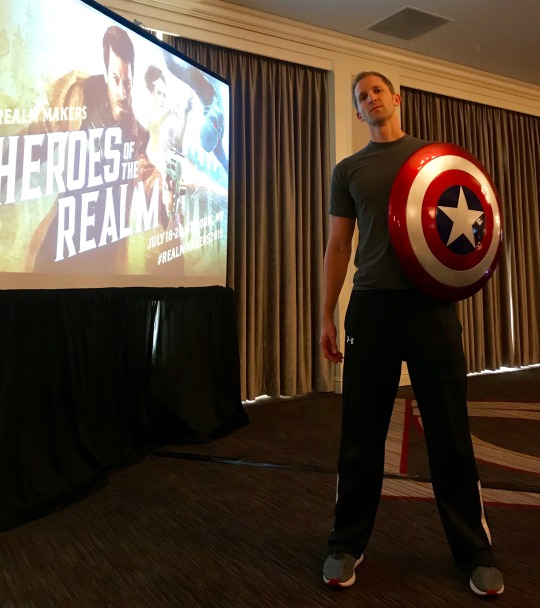
But you may be asking why in the world twenty-something people would volunteer for anything so involved as a publishing company. Well, it's because of the spirit of said company. And I was reminded of that in a big way this past weekend.
The Realm Makers writing conference is the summer highlight for a very specific group of about 300 people. You see, we're all Christians, writers, and… kind of weird. That is, we're geeks and nerds. We collect Marvel comics, write dragon stories, and wear ridiculous costumes. And we never feel more at home than when we're among our own people.
Becky Minor and a faithful few created this conference several years ago, and I've been a part of it since the beginning. Which means I've formed some deep friendships with some amazing people, most of whom I don't see in person anywhere other than this conference. And over the years, I've had the joy of watching them grow from scared, flightless writers to bold, soaring authors. So many of them have forged their own path into the wild world, and many more have joined the ranks as wide-eyed newbies. And we all continue to have the same spirit of inclusiveness and excitement for the craft and industry of fiction stories, but unfortunately, we often also share the pain of rejection in said industry. And that's exactly where Havok Publishing comes in.

You see, there are a lot of readers out there. And there are also plenty of writers. But sometimes, getting good stories from writers to readers can be tricky. Polishing stories takes time. As does packaging them and delivering them into the right hands. And time is money, so many writers simply don't have the resources to get the job done, which is exactly why publishers exist. But publishers need to make money, too, which means they're often only willing to offer publishing contracts to the biggest and most well-established names in the industry. And only to the most exciting and well-packaged novels. And all of this leaves a very big hole in the process: providing new writers with an opportunity to improve their craft and put their polished stories in front of readers (other than their grandmas). And when I almost let Havok die last year, that was the only reason I didn't. We truly were a company that provided the bridge for those new writers. And we were one of the only ones in our corner of the industry doing it.
Since then, we've grown at a staggering rate. We've flipped our production and delivery model on end. We've turbo-charged our marketing. And we've been met by hordes of supporters that continue to push us forward toward great things. But, as I said, we're all volunteers. So twenty-something hours per week of pouring in without getting much back except "Good Job" stickers can take its toll. So when we were starting to feel beat down, I encouraged us all to wait until that always-magical Realm Makers weekend before losing heart. And, if I must say, I was right.
The weeks leading up to the conference were a blur. We were busy curating the best stories we'd acquired over the past six months into our first anthology, and unless you've ever published your own book (correctly), I can't possibly tell you how involved the process in. But just know that we barely made it in time. We didn't do everything right, but the final product looked amazing, and seventy-two copies of it came with us for sale in the conference bookstore.
And less than twenty-four hours after the conference began, we sold out.

Yes, all seventy-two books that we ambitiously printed, loaded up, and put on display among so many other amazing novels, anthologies, comics, and crafts completely sold out in less than a day. And I was completely floored. And through the rest of the conference, other writers and fans continued to ask how they could purchase our anthology. They bought t-shirts and went online and bought the anthology there (which you can do by clicking on this link to amazon.com). And it took me a while to figure out how in the world that could have happened.
But slowly, it dawned on me: it was the spirit of Havok. We foster and nurture eager young writers. We build them up. We guide them. We give them hope. And we set them up for success in what is oftentimes their first real publication. And they, in turn, are the ultimate rockstars and advocates for what we're doing. Probably half of those seventy-two anthology copies were bought by authors who were published in it (for gifts for their friends and family), and the other half were snatched up by Realmies (the affectionate name for the Realm Makers tribe/attendees) who felt the palpable excitement generated by those of us involved in the magic.
I think there were eighteen of the Havok Hive (the name for Havok's collective volunteer staff… you will be assimilated) in attendance at this year's Realm Makers. And as a small token, Cerberus (the name for the aforementioned three heads of Havok, myself being one of them. Yes, I know. We have a lot of strange titles. Didn't I warn you that we're weird?) gifted them with bright orange Havok lanyards. And as the Hive busied itself about the conference, helping here and there where needed, it unwittingly lightened the tensions weighing on those young writers whom we love so much. As one woman told me on the last night of the conference, "Every time I see an orange lanyard, I know the person wearing it will be encouraging. Like I can actually do this thing."

And that's when I knew we'd won. We'd accomplished, for the moment, what we set out to do. We'd given back to a conference and a culture that had already made such a difference in the lives of so many. We'd played our small but essential part in the process. And we will continue to do so. We're acquiring hundreds of stories each year. We're putting the best of those stories in beautiful anthologies alongside some of the industry’s biggest names. We're putting our energy and resources directly back into our authors and projects that will benefit them. And we're doing it all because we love it. And we love them. And we couldn't do any of it without that constant reminder. So, thank you, everyone, who has supported Havok Publishing along the way. You're helping us make a difference in the lives of so many creatives. And, in turn, you're helping their stories make a change in this world.
We're doing good work here at Havok, and it takes a village… or in this case, a Hive… or a Horde. I don't know. Maybe we do need to reconsider how many strange labels we're putting on everything. But you get my drift. Together, we’re weird. We’re writers. And we’re wonderful. Write on!

#realm makers#realm makers 2019#havok publishing#flash fiction#amwriting#amediting#short stories#science fiction
4 notes
·
View notes
Photo


World Trigger - Volume 19 Extras Part 4/4
From Hiatus to Return
Thank you very much for buying World Trigger volume 19. World Trigger entered a long-term hiatus between the 2016 50th Issue of Weekly Shounen Jump and the 2018 47th Issue (according to Wikipedia), and during that time I received a lot of encouragement and letters worrying over me from the fans, so I thought I would explain the course of events from hiatus to return to transfer here.
The reason for the hiatus is because I damaged my neck, but in the first place I believe it was due to how I recklessly took on too much work (besides the weekly manuscript) without considering my capacity, and then not being able to properly cut corners (conserve energy) on those subsidiary jobs.
After I damaged my neck, for a time I was given a week’s rest every 4 to 5 issues to deal with it, but the symptoms gradually grew worse. A high quality pain penetrated through the painkillers and spread from my neck to my back and head, there were more times when I couldn’t get up, manuscripts were delayed, and the result was that I entered a dark downward spiral where I had to push myself even further, drinking energy drinks every 2 hours to force my body to move in the style of a doping enemy from a sports manga to do my work. Perhaps because of that, I was becoming more and more worn down mentally, my eyes were spinning and in the end I was having trouble speaking.
Sensing my evil aura, my editor put a stop to it, and it was decided I would go on an indefinite hiatus.
According to my manager, it seems I have a habit of acting cool in front of my editor, and there were several times when I would say ‘I. Can. Do. It. Somehow. Probably.’ Even though I was kind of on the verge of death. So if my editor hadn’t stopped me here then there was the chance it could have gotten even worse. Nice work, editor.
For about a month after starting the hiatus, I pretty much lived on my back. From the 2nd month, I was able to get up for about 4, 5 hours a day, and from the 3rd month I could move around for about half a day.
Because I became unable to ride inside anything after damaging my neck (I would get dizzy after about 15 minutes from the pain in my neck), it was about 6 months into the hiatus that I could be properly looked at in a hospital.
I went to several different hospitals, but all the doctors said the same things: ‘if you continue the treatment and keep resting, you will keep getting better’, ‘for now, it’s important not to push yourself in the future. If yo push yourself you will of course get worse’, ‘it’s an occupational disease, the kind that follows you for life, so if you can I recommend you transfer to a job that’s easier on your neck’. Telling my editor left us feeling pretty down: ‘I can’t really imagine weekly serialisation that won’t make you push yourself…’ ‘Yeah…’.
I couldn’t keep making trouble for Jump, and it would soon be 1 year into the hiatus, it may be impossible to restart serialisation…
As I thought that, one day, I heard from my editor: ‘Ashihara-san, how do you feel about transferring?’
According to him, the problem with weekly serialisation is its killer schedule that doesn’t allow for ‘resting for a day because you’re really not feeling well’. If it’s the web-based ‘Jump+’, each work can be given its own deadline, so you can serialise at whatever pace you’d like. Besides that, transferring to a monthly magazine would also allow a certain amount of adjustment on the number of pages to be drawn that month. Since the worst case scenario would be ‘pushing myself too hard I had to stop writing World Trigger’, so it might be better to match how I’m feeling and draw at a pace of ‘I can manage this’. Well, it wasn’t something to be decided immediately, so if I could just consider this an option…
The more I heard, the better it sounded, and it was something I was very grateful for. But it worried me, considering my social standing as a trash author who had been on hiatus for close to a year.
I was quite attached to Jump, and ‘doing my best at the best magazine in Japan’ was also my motivation, so I was conflicted on what it would be like if I left Jump. But there was the fundamental problem of how many more years it would take me to recover enough to serialise weekly, and whether I could even recover to that extent in the first place, and furthermore I wanted to allow all the readers who still haven’t forgotten World Trigger even after over a year to read the continuation as soon as possible, so in the end I asked my editor to request a transfer.
‘If you request it, I will do my best to allow you to transfer to where you want’, I was told, so I discussed where to transfer with my manager.
Personally, I was still hung up on the paper medium, and due to the reasons of even I knowing about the works serialised in it and that it’s easy to buy it from places like convenience stores, I requested ‘Jump SQ’. Both Jump and SQ editorial departments went to great efforts, and a lot happened after as well, until the transfer was decided. I was able to safely restart serialisation.
I would like to once again thank the editorial department of Weekly Shounen Jump, the editorial department of Jump SQ, my editors from both departments, and all the readers who encouraged me even during the hiatus. Thank you very much.
Since the chapter I restart serialisation on (chapter 165) is the first in about 2 years, for an instant I considered whether to start it in a special way, but I felt it would seem unnatural when it’s made into a manga volume, so I deliberately went ahead as normal.
From now on, the pace would slow down from when it was a weekly serialisation, but I think I will be able to put out a manga volume at regular intervals. My neck currently have recovered to the point that I can live normally, but I have been told by the SQ editorial department that I am ‘strictly prohibited from pushing myself’, so if the published pages decrease, I would be grateful if you can consider it as ‘playing it safe this month’.
Also, since I want to repay Jump SQ for picking up ‘World Trigger’, if you have the time and a bit more than 600 yen a month, I would be very happy if you can subscribe to Jump SQ. If you are already subscribed, I look forward to your readership.
I will do my best.
~Ashihara Daisuke
As the last part of the extras from volume 19, I also want to take this chance to mention some of the edits made from the magazine version. There were no plot-relevant changes this time, mostly some minor differences in clothing patterns etc. (and now that we know the clothes in the magazine isn’t always decided by Ashihara and he would change it if he thinks it’s necessary, I wonder if he has headcanons for everyone’s fashion choices as well).
But one funny change I want to point out is this from ch162:

Reiji wasn’t wearing a seatbelt in the magazine, and I guess Ashihara didn’t want him to break the law lol
The other kind of major change (in my perspective at least) are these radar panels from ch165 and ch167:


Both of these radars now show LOW, matching Yuzuru’s HIGH in ch171. Showing us that radar is capable of showing whether someone is above or below you, though that’s still not very helpful in an urban environment as the top panel shows.
An earlier Q&A has said that elevation can’t be displayed on radar, so either this is the first time we’ve had a retcon, radar got beefed up without it being noted in story (yet), an operator added that through process of elimination, there’s some other reason, or Ashihara just forgot. Since this is World Trigger, any of these are possible.
As always, credit goes to this wonderful site that records all changes from magazine to manga volume. Please check here if you want to know about all the minor changes as well.
In conclusion, for all of you who wanted to know about the specific details of Ashihara’s illness, here it is.
95 notes
·
View notes
Text
Islamophobia: A “Zionist Plot”?

In response to Hating Muslims, Loving Zionists: Israel a Far-Right Model, where Al Jazeera gets everything wrong
Al Jazeera penned an opinion piece trying to lump anti-Muslim terrorism, rational critics of Islamism with Zionism of all things. The “logic” goes that “x Israeli politician is a far-righter”, many leading political figures in far-right politics that criticize Islam have expressed affection and approval for Israel; Palestine is oppressed by Israel and as such all of these things are related to each other. They even used the censored picture of Brenton Tarrant to drive the point home that “See? if you hate Islam, you are also just like this guy and oh, you support Israel too”.
I can’t even begin pointing out what is wrong with this “some x are y, some y are z, therefore x are y” fallacy, I am even more surprised that right-winged critics of Israel didn’t even try to debunk it. In one hand, it’s pretty observable that support for Israel is strong among mainstream conservatism than other movements across the political spectrum. On the other hand, there is one figure who is never discussed when the topic of alt-right and Zionism overlap, being very little-known outside of Israel.

This is Meir Kahane, a ultra-Orthodox Jewish rabbi from the USA who migrated from to Israel and was a co-founder of the Jewish Defense League and the Kach political party. Also known as “Israel’s Ayatollah”, he urged the establishment of a Jewish theocracy codified by Maimonides (a Reconquista-era Spanish Jew), the immigration of all American Jews to Israel before a “second Holocaust” could take place and was very vocal about advocating the annexation of the West Bank and Gaza, violence against Palestinians and those he deemed as “anti-semites”. He was extremely divisive: there were people who found his Jewish supremacist rhetoric intolerable and equated him to the Nazis, while in other camp you had those who supported him largely because of Arab aggression as The Los Angeles Times reported that “[he] is a reaction to the wanton murders of innocent men, women and children in Israel” (which you can find many parallels with modern day politicians supported by the alt-right). Kahane was arrested at least 62 times by Israeli authorities for inciting hatred.
While in prison, Kahane wrote a manifesto titled “They Must Go” where he advocates the complete exile of Palestinians and the necessary process how to do it arguing that if they didn’t they’d begin outbreeding the Jewish population and take over Israel in 20 years (he wrote it in the 80s). His manifesto reads a lot like the anxiety Europeans feel about Muslim migrants which isn’t alleviated in the slightest by them speaking out in the open how they will establish a European caliphate.
Kahane was popular enough with the Israelis that he was elected with one seat to the Knesset. However, he was never really popular with his fellow parliamentarians, whom he regarded as “Hellenists” (Jews who assimilated into Greek culture after being conquered by Alexander the Great), since Kahane thought they weren’t Jewish enough. Most of his proposed laws included: imposing compulsory religious education, stripping citizenship status of all non-Jewish citizens (including Christians) and demanding that relations with Germany and Austria being cut but monetary compensation for the Holocaust being kept.
In 1990, Kahane was assassinated by an al-Qaeda member (it’s believed he was one of the first victims of the terrorist group), who was initially cleared of the murder, but was arrested later for being implicated in the 1993 WWC bombing attempt, where he confessed his first crime and was jailed to life imprisonment. His death made him a martyr leading to Kach member Baruch Goldstein to swear revenge and in 1994, he walked into the Cave of the Patriarchs on the West Bank and shot up the place, killing 30 Muslims before being lynched by the survivors. Given the Cave of the Patriarch status as a important religious site to Islam, this atrocity would have provoked probably worse reactions than Christchurch.
While researching about these things, I couldn’t help but see so many parallels between that and the Christchurch mosque incident. Kahane’s manifesto reads a lot like Tarrant’s own. Even if they were not familiar with Kahane’s own views, it was probably not lost to those that really read into Tarrant’s manifesto that not once he denounces the State of Israel for the current state of Europe - instead he blames Angela Merkel, Reccep Erdogan and Sadiq Khan, straight up calling for their deaths. This seemed enough for many people to conclude Tarrant was an Mossad agent.
To those reading this you may be asking: you listed so many things in common with the alt-right, Islamophobia and Zionism, so what did Al Jazeera get wrong?
Ah, if you actually paid attention to the fringe discourse, you realize that nothing discredits you faster than declaring yourself far-right and voicing support for Israel. I sincerely doubt that white supremacists would have liked a Jewish supremacist like Kahane, specially his demands that Germany to continue paying reparations forever. The fringe right actually finds lots of solidarity with Palestinians and common ground with the liberal left than either side cares to admit. Sure many right-wing politicians happen to be Zionists, but those are the mainstream old guard.
I also observed that they also are overwhelmingly in support of Syrian president Bashar al-Assad in large part because he is an authoritarian model that stands up against Israel. Does it mean that all people who support Assad are also the same? No. Many support Assad because he is considered a bulwark against Islamism (even though he is a Muslim himself, albeit not considered one by terrorist extremists because he is Alawite). Despite his many flaws, normal people are willing to stand up for him because he represents stability in Syria.
I also take huge issue with Palestinians being referred to as exclusively Muslim because it erases their small and long-suffering Christian minority, which is never on anyone’s minds every time someone discuss the Israeli-Palestinian conflict, despite the fact that Palestinian Christians played a huge role in resistance against Israel before the rise of Islamism ended up alienating them and Christians across the Middle-East aren’t necessarily thrilled about Israel either, not even Israeli Christians themselves.
It’s probably no coincidence that Al Jazeera, who denounces both Israel and the Assad regime who are antagonistic to each other, also happen to be big Islamist apologists which explains why they insist in portraying the Palestinian cause as a religious struggle rather than a nationalist one. It’s in their interest to denigrate critics of Islamism who run across the board in the political spectrum from atheists like Bill Maher and Sam Harris, Christians like David Wood, Brother Rachid and Zacharias Botros and Muslims like Majid Nawaz, Ed Hussein and Mohammed Tawid and many, many, many people worried about the dangers of Islamism, which they use so vociferously the term “Islamophobia” coined by the Muslim Brotherhood, a terrorist organization disguised as political party. This way they can lump all the opposition into one camp and paint them as Zionist Islamophobes.
With all that said, the rise of conservatism and nationalism across the world is co-related with the modern liberal left’s weakness to confront the Islamist Question. One of the key reasons that led to Donald Trump’s election were fears of Hillary Clinton increasing immigration as observed by the skyrocketing of sexual abuse cases in Western Europe. Even though he is a more despotic and authoritarian figure than Trump, Erdogan from Turkey is subjected to much less scrutiny from the Western media when he locks up more journalists anywhere in the world.
And this isn’t contained to the West either, the Bharatiya Janata Party characterized as Hindu nationalist and anti-Islamic continues being elected into power because of India’s spats with Pakistan and being formed in the first place because of Indian secularists appeasing to Muslims. And if the future is any indication, you can expect more persecutions of Muslims in Sri Lanka by Buddhists and Christians after the Easter bombings from this year. Those has less to do with Zionism and more with the fear of Islamism.
There is a good reason why I brought up Kahane into this editorial: much like modern day politicians, he was considered too radical by the status quo of the time yet gained the support of a silent majority like modern day because the current status quo proved intolerable. The same thing happened in my country with Jair Bolsonaro, who was already saying absurd things as early as the 90s and would never be considered as President of Brazil yet here we are, though Kahane was assassinated before he got the chance of being Prime Minister.
How many times are we going to deflect the problem like Al Jazeera before we confront it straight in the eye?
3 notes
·
View notes